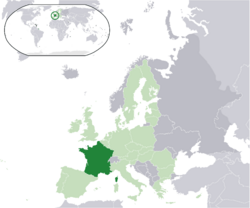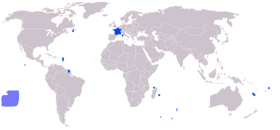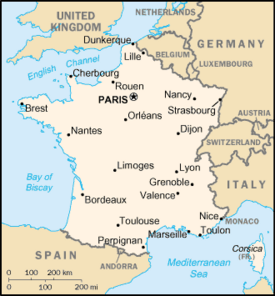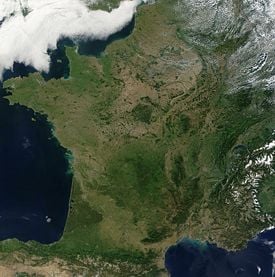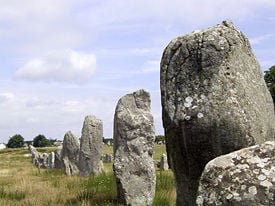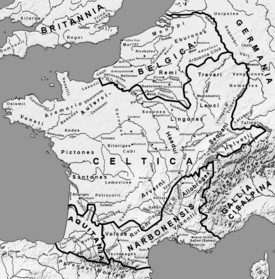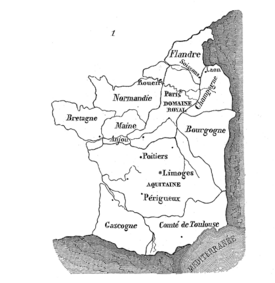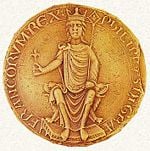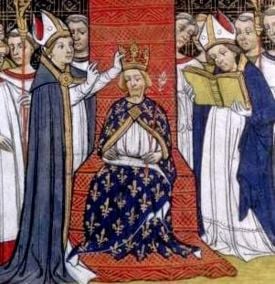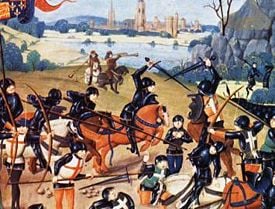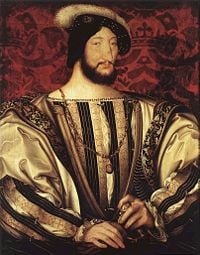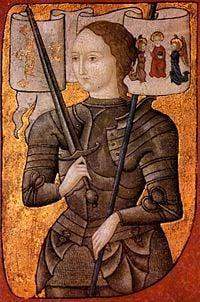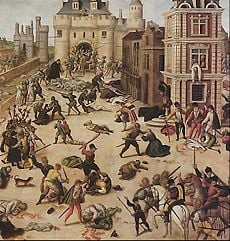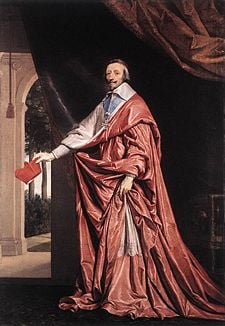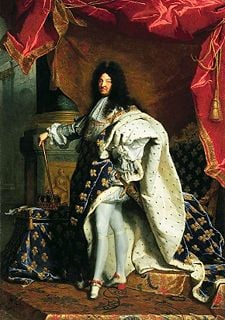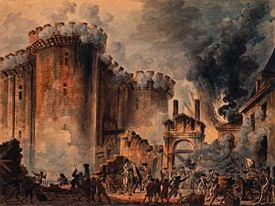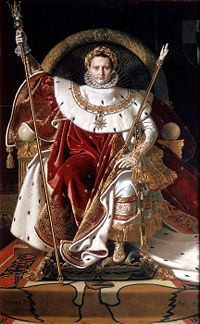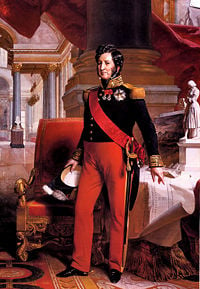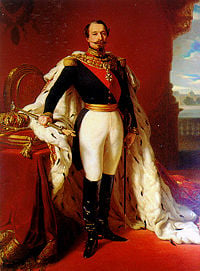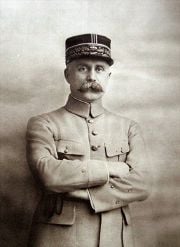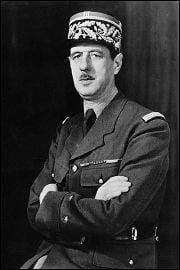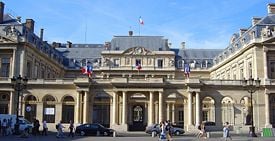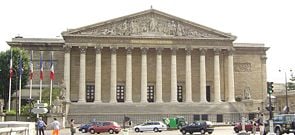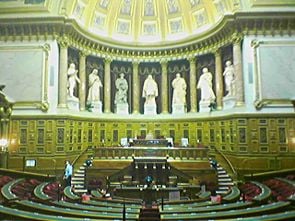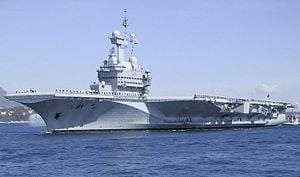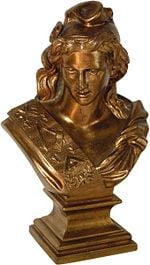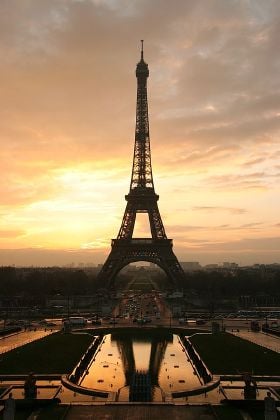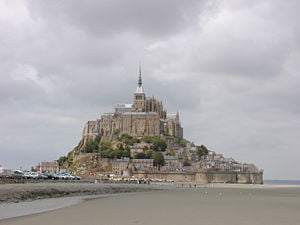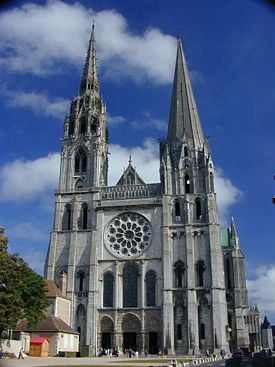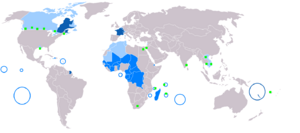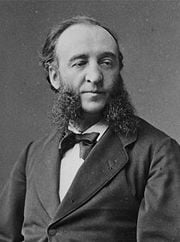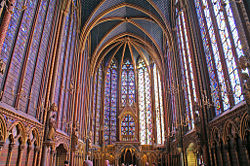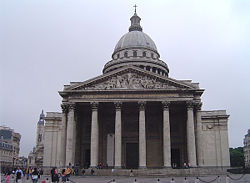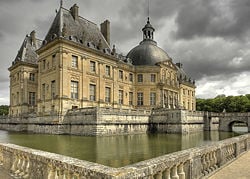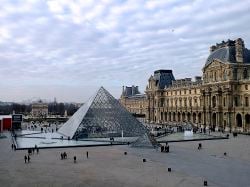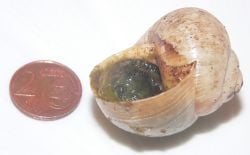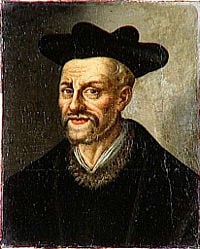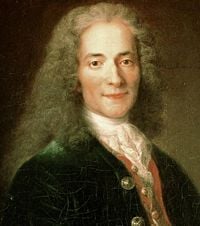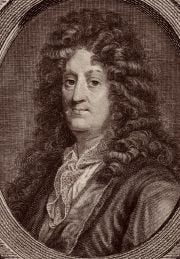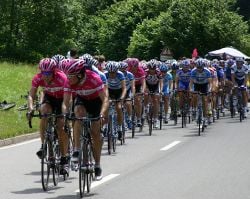Difference between revisions of "France" - New World Encyclopedia
m (Rename to Geography) |
|||
| (142 intermediate revisions by 10 users not shown) | |||
| Line 1: | Line 1: | ||
| − | {{ | + | {{Approved}}{{Submitted}}{{Images OK}}{{Paid}}{{Copyedited}} |
| − | ''' | + | {{Infobox Country |
| + | |native_name = {{native name|fr|République française|icon=}} | ||
| + | |conventional_long_name = French Republic | ||
| + | |common_name = France | ||
| + | |official_languages = French | ||
| + | |demonym = French | ||
| + | |national_motto = <br />''[[Liberté, égalité, fraternité|Liberté, Égalité, Fraternité]]''<br />(Liberty, Equality, Fraternity) | ||
| + | |national_anthem = "[[La Marseillaise]]" | ||
| + | |image_flag = Flag of France.svg | ||
| + | |image_coat = Armoiries république française.png | ||
| + | |symbol_type = National Emblem (unofficial) | ||
| + | |image_map = Location France EU Europe.png | ||
| + | |map_caption = {{map_caption |countryprefix='''Metropolitan'''|region=on the [[Europe|European continent]] |subregion=the [[European Union]] |location_color=dark green |subregion_color=light green |region_color=dark grey |legend=}} | ||
| + | |image_map2 = Overseasfrancemap.png | ||
| + | |map_caption2 = <p style="margin-top:0;margin-bottom:-2px;line-height:1em;"><span style="font-size:11px;">Territory of the '''French Republic''' in the world<br />(excl. Antarctica where sovereignty is suspended)</span> | ||
| + | |capital = [[Paris]] | ||
| + | |latd = 48 | ||
| + | |latm = 51.4 | ||
| + | |latNS = N | ||
| + | |longd = 2 | ||
| + | |longm = 21.05 | ||
| + | |longEW = E | ||
| + | |largest_city = capital | ||
| + | |government_type = [[Unitary state|Unitary]] [[Semi-presidential system|semi-presidential]] republic | ||
| + | |leader_title1 = [[President of France|President]] | ||
| + | |leader_title2 = [[Prime Minister of France|Prime Minister]] | ||
| + | |leader_name1 = [[Emmanuel Macron]] | ||
| + | |leader_name2 = [[Édouard Philippe]] | ||
| + | |legislature = [[Parliament of France|Parliament]] | ||
| + | |upper_house = [[Senate of France|Senate]] | ||
| + | |lower_house = [[National Assembly of France|National Assembly]] | ||
| + | |sovereignty_type = [[History of France|Formation]] | ||
| + | |sovereignty_note = | ||
| + | |established_event1 = [[Francia]] | ||
| + | |established_event2 = [[West Francia]] | ||
| + | |established_event3 = [[Constitution of France|Current constitution]] | ||
| + | |established_date1 = 486 (Unification by [[Clovis I|Clovis]]) | ||
| + | |established_date2 = 843 ([[Treaty of Verdun]]) | ||
| + | |established_date3 = 5 October 1958 ([[French Fifth Republic|5th Republic]]) | ||
| + | |accessionEUdate = 25 March 1957 | ||
| + | |EUseats = 78 | ||
| + | |FR_metropole = [[Metropolitan France|Metropolitan France]] | ||
| + | |FR_IGN_area_km2 = 551695 | ||
| + | |FR_IGN_area_rank = 47th | ||
| + | |FR_IGN_area_magnitude = 1 E11 | ||
| + | |FR_cadastre_area_magnitude = 1 E11 | ||
| + | |FR_IGN_area_sq_mi = 213010 | ||
| + | |FR_cadastre_area_km2 = 543965 | ||
| + | |FR_cadastre_area_rank = 47th | ||
| + | |FR_cadastre_area_sq_mi = 210026 | ||
| + | |area_km2 = 674843 | ||
| + | |area_sq_mi = 260558 <!--Do not remove per [[WP:MOSNUM]]—> | ||
| + | |area_rank = 41st | ||
| + | |area_magnitude = 1 E11 | ||
| + | |FR_foot =<ref name=whole_territory>Whole territory of the French Republic, including all the [[overseas department]]s and [[Overseas territory (France)|territories]], but excluding the French territory of [[Adélie Land|Terre Adélie]] in [[Antarctica]] where sovereignty is suspended since the signing of the [[Antarctic Treaty]] in 1959.</ref> | ||
| + | |FR_foot2 =<ref name=IGN_figure>{{fr}} French [[Institut Géographique National|National Geographic Institute]] data.</ref> | ||
| + | |FR_foot3 =<ref name=cadastre_figure>French [[Land Register]] data, which exclude lakes, ponds and [[glacier]]s larger than 1 km² (0.386 sq mi or 247 acres) as well as the estuaries of rivers.</ref> | ||
| + | |FR_foot4 =<ref name=whole_territory /> | ||
| + | |FR_foot5 =<ref name=metropolitan_France>[[Metropolitan France]] only.</ref> | ||
| + | |FR_total_population_estimate = 67,013,000<ref name=population>{{fr}} [https://www.insee.fr/fr/statistiques/1892086?sommaire=1912926 Population totale par sexe et âge au 1er janvier 2018, France] ''Bilan démographique 2017''. Retrieved June 29, 2018.</ref> | ||
| + | |FR_total_population_estimate_year = 2017 estimate | ||
| + | |FR_total_population_estimate_rank = 20th | ||
| + | |FR_metropole_population = 64,880,000 | ||
| + | |FR_metropole_population_estimate_rank = 22nd | ||
| + | |population_density_km2 = 116 | ||
| + | |population_density_sq_mi = 301 <!--Do not remove per [[WP:MOSNUM]]—> | ||
| + | |population_density_rank = 89th | ||
| + | | GDP_PPP = $2.835 trillion<ref name="France GDP">International Monetary Fund, [http://www.imf.org/external/pubs/ft/weo/2018/01/weodata/weorept.aspx?pr.x=55&pr.y=9&sy=2017&ey=2018&scsm=1&ssd=1&sort=country&ds=.&br=1&c=132&s=NGDPD%2CPPPGDP%2CNGDPDPC%2CPPPPC&grp=0&a= Report for Selected Countries and Subjects: France] ''World Economic Outlook'', April 2018. June 29, 2018</ref> | ||
| + | | GDP_PPP_year = 2017 | ||
| + | | GDP_PPP_rank = 10th | ||
| + | | GDP_PPP_per_capita = $43,760<ref name="France GDP"/> | ||
| + | | GDP_PPP_per_capita_rank = 26th | ||
| + | | GDP_nominal = $2.583 trillion<ref name="France GDP"/> | ||
| + | | GDP_nominal_year = 2017 | ||
| + | | GDP_nominal_rank = 7th | ||
| + | | GDP_nominal_per_capita = $39,869<ref name="France GDP"/> | ||
| + | | GDP_nominal_per_capita_rank = 22nd | ||
| + | | Gini = 30.1<!--number only—> | ||
| + | | Gini_year = 2013 | ||
| + | | Gini_change = <!—increase/decrease/steady—> | ||
| + | | Gini_ref = <ref name="CIA">{{cite web |url=https://www.cia.gov/library/publications/the-world-factbook/fields/2172.html |title=Field Listing :: Distribution of Family Income – GINI Index |website=The World Factbook |publisher=CIA}}</ref> | ||
| + | | Gini_rank = | ||
| + | |HDI_year = 2011 | ||
| + | |HDI = {{increase}} 0.884<ref name="HDI">{{cite web|url=http://hdr.undp.org/en/media/HDR_2011_EN_Table1.pdf|title=Human Development Report 2011|year=2011|format=PDF|publisher=United Nations|accessdate=April 29, 2017}}</ref> | ||
| + | |HDI_rank = 20th | ||
| + | |HDI_category = <span style="color:#090;">very high</span> | ||
| + | |currency = Euro,<ref>Whole of the French Republic except the overseas territories in the Pacific Ocean.</ref> [[CFP franc]]<ref>French overseas territories in the Pacific Ocean only.</ref><br /> | ||
| + | |currency_code = EUR,{{Spaces|4}}XPF | ||
| + | |time_zone = CET<ref name=metropolitan_France /> | ||
| + | |utc_offset = +1 | ||
| + | |time_zone_DST = CEST<ref name=metropolitan_France /> | ||
| + | |utc_offset_DST = +2 | ||
| + | |drives_on = right | ||
| + | |cctld = [[.fr]]<ref>In addition to [[.fr]], several other Internet TLDs are used in French overseas ''départements'' and territories: [[.re]], [[.mq]], [[.gp]], [[.tf]], [[.nc]], [[.pf]], [[.wf]], [[.pm]], [[.gf]] and [[.yt]]. France also uses [[.eu]], shared with other members of the European Union. The [[.cat]] domain is used in [[Catalan Countries|Catalan-speaking territories]].</ref> | ||
| + | |calling_code = [[Telephone numbers in France|33]]{{Smallsup|1}} | ||
| + | |ISO_3166-1_alpha2 = | ||
| + | |ISO_3166-1_alpha3 = FRA | ||
| + | |ISO_3166-1_numeric = | ||
| + | |sport_code = FRA | ||
| + | |vehicle_code = F | ||
| + | |footnote1 = The overseas regions and collectivities form part of the [[French telephone numbering plan]], but have their own country calling codes: [[Guadeloupe]] +590; [[Martinique]] +596; [[French Guiana]] +594, [[Réunion]] and [[Mayotte]] +262; [[Saint Pierre and Miquelon]] +508. The overseas territories are not part of the French telephone numbering plan; their country calling codes are: [[New Caledonia]] +687, [[French Polynesia]] +689; [[Wallis and Futuna]] +681 | ||
| + | |footnote2 = Spoken mainly in overseas territories | ||
| + | }} | ||
| − | + | '''France''', officially the '''French Republic''', is a [[country]] whose [[Metropolitan France|metropolitan territory]] is located in [[Western Europe]] and that also comprises various overseas islands and territories located in other continents. French people often refer to Metropolitan France as ''L'Hexagone'' (The "[[Hexagon]]") because of the geometric shape of its territory. | |
| − | + | ||
| − | + | The French Republic is a [[unitary state|unitary]] [[semi-presidential system|semi-presidential]] [[republic]] with more than 200 years of democratic traditions, and about 500 years as a unified European state. | |
| − | + | ||
| + | France ranks among the world's most influential centers of cultural development. It is the place of origin of the [[French language]] and [[civil law]] forms the basis of the [[legal systems]] of many countries. The nation was the center of the [[French Empire]], and the birthplace of the [[French Revolution]]. French political and social ideas influenced Europe and America. | ||
| + | {{toc}} | ||
| + | [[History of Christianity|Christianity]] took root in France in the second century, and became so firmly established that France obtained the title "Eldest daughter of the Church," and the French would adopt this as justification for calling themselves "the Most Christian Kingdom of France." Later France produced a series of philosophers noted for radical [[skepticism]], and [[atheism]]. | ||
| − | |||
| − | |||
==Geography== | ==Geography== | ||
| − | + | [[Image:Fr-map.png|thumb|left|275px|Map of metropolitan France.]] | |
| + | [[Image:Satellite image of France in August 2002.jpg|thumb|left|275px|Satellite picture of metropolitan France, August 2002.]] | ||
| + | The name "France" comes from [[Latin]] ''Francia,'' which literally means "land of the Franks" or "Frankland." France is bordered by [[Belgium]], [[Luxembourg]], [[Germany]], [[Switzerland]], [[Italy]], [[Monaco]], [[Andorra]], and [[Spain]]. It is also linked to the [[United Kingdom]] by the [[Channel Tunnel]], which passes underneath the [[English Channel]]. [[Corsica]] lies off the [[Mediterranean Sea|Mediterranean]] coast. | ||
| + | |||
| + | While Metropolitan France is located in [[Western Europe]], France also has a number of territories in [[North America]], the [[Caribbean]], [[South America]], the southern [[Indian Ocean]], the [[Pacific Ocean]], and [[Antarctica]]. These territories have varying forms of government ranging from [[overseas department]] to [[overseas collectivity]]. | ||
| + | |||
| + | Metropolitan France covers 213,010 square miles (551,695 square kilometers), making it the largest country in area in the [[European Union]], being only slightly larger than [[Spain]], or slightly less than the size of [[Texas]], in the [[United States]]. | ||
| − | + | France possesses a wide variety of landscapes, from coastal plains in the north and west to mountain ranges of the [[Alps]] in the southeast, the [[Massif Central]] in the southcentral and [[Pyrenees]] in the southwest. At 15,770 feet (4807 meters) above sea-level, the highest point in Western Europe, [[Mont Blanc]], is situated in the Alps on the border between France and [[Italy]]. | |
| − | |||
| − | |||
| − | |||
| − | |||
| − | |||
| − | |||
| − | Metropolitan France | + | Metropolitan France lies within the [[northern temperate zone]]. The north and northwest have a temperate climate, however, a combination of maritime influences, [[latitude]] and [[altitude]] produce a varied climate in the rest of the country. In the southeast a [[Mediterranean climate]] prevails. In the west, the climate is predominantly [[oceanic climate|oceanic]] with a high level of [[rain]]fall, mild winters and cool summers. Inland the climate becomes more [[Continental climate|continental]] with hot, stormy summers, colder winters and less rain. The [[climate of the Alps]] and other mountainous regions are mainly [[Alpine climate|alpine]] in nature with the number of days with [[temperature]]s below freezing over 150 per year and snowcover lasting for up to six months. |
| − | + | France has extensive [[river]] systems such as the [[Loire River|Loire]], the [[Garonne]], the [[Seine]] and the [[Rhône River|Rhône]], which divides the Massif Central from the Alps and flows into the Mediterranean Sea at the [[Camargue]]. The lowest point in France is 6.5 feet (two meters) below sea level. | |
| + | |||
| + | A major divide, running from the southern end of the Vosges down the eastern and southeastern edge of the Massif Central to the Noire Mountains, is the source of most of the rivers of the larger, western part of the country, including the [[Seine]] and the [[Loire]]. Other main rivers are the [[Garonne]], flowing from the Pyrenees, and the [[Rhône]] and the [[Rhine]], originating in the Alps. | ||
| + | |||
| + | France has [[forest]]s of chestnut and beech in the Massif Central, juniper and dwarf pine in the sub-alpine zone, with pine forests and various [[oak]]s in the south. [[Eucalyptus]] from [[Australia]] and dwarf pines abound in [[Provence]], while [[olive]] trees, vines, [[mulberry]], [[fig]] trees, as well as [[laurel]], wild [[herb]]s, and ''maquis'' scrub grow in the Mediterranean area. | ||
| + | |||
| + | Brown [[bear]], chamois, [[marmot]], and alpine hare live in the Pyrenees and the Alps. Polecats, marten, wild boar, and various [[deer]] live in the forests. [[Hedgehog]], [[shrew]], [[fox]], [[weasel]], [[bat]], [[squirrel]], [[badger]], [[rabbit]], [[mouse]], [[otter]], and [[beaver]] are common. [[Bird]]s include warblers, thrushes, magpies, owls, buzzards, and gulls. There are storks in Alsace, [[eagle]]s and [[falcon]]s in the mountains, pheasants and partridge in the south. [[Flamingo]]s, [[tern]]s, [[bunting]]s, [[heron]]s, and [[egret]]s are found in the Mediterranean zone. The rivers contain [[eel]]s, pike, [[perch]], carp, roach, [[salmon]], and [[trout]], while [[lobster]] and [[crayfish]] are found in the [[Mediterranean Sea]]. | ||
| + | |||
| + | France's [[natural resource]]s includes [[coal]], [[iron ore]], [[bauxite]], [[fish]], [[timber]], [[potash]], and [[zinc]]. Natural hazards include [[flood]]ing, [[avalanche]]s, and forest fires. Environmental issues include forest damage from [[acid rain]], [[air pollution]] from industrial and vehicle emissions, [[water pollution]] from urban wastes, and agricultural run-off. | ||
| + | |||
| + | [[Paris]], the capital city, is situated on the [[Seine|River Seine]], in northern France, at the heart of the [[Île-de-France]] region. The city of Paris had an estimated population of 2,153,600 within its administrative limits in 2006. The Paris urban area extends well beyond the administrative city limits and has a population of 9.93 million. An important settlement for more than two millennia, Paris is today one of the world's leading [[business]] and [[cultural]] centers, and its influence in [[politics]], [[education]], [[entertainment]], [[Mass media|media]], [[fashion]], [[science]] and the [[arts]] all contribute to its status as one of the world's major [[Global city|global cities]]. | ||
| + | |||
| + | {{wide image|Paris arc.jpg|1050px|<center>'''Paris'''</center>}} | ||
==History== | ==History== | ||
| − | + | [[Image:Carnac megalith alignment 1.jpg|thumb|275px|The Menec alignments, the most well-known megalithic site amongst the [[Carnac stones]].]] | |
| − | [[Image: | + | ===Pre-history=== |
| − | The | + | The [[Neanderthal]]s, the earliest ''Homo sapiens'' to occupy Europe, are thought to have arrived there around 300,000 B.C.E., but seem to have died out by about by 30,000 B.C.E. The earliest modern humans—[[Cro-Magnon]]s—entered Europe (including France) around 40,000 years ago during a long [[interglacial]] period, when Europe was relatively warm, and food was plentiful. They brought with them sculpture, engraving, painting, body ornamentation, music and the painstaking decoration of utilitarian objects. Some of the oldest works of art in the world, such as the [[cave painting]]s at [[Lascaux]] in southern France, are datable to shortly after this migration. |
| − | + | During the [[Neolithic]] period (ca. 4500 B.C.E.–1700 B.C.E.), which is characterized by the adoption of [[agriculture]], the development of [[pottery]] and more complex, larger settlements, there was an expansion of peoples from southwest Asia into Europe. From the Neolithic to the [[Bronze Age]] (2000-800 B.C.E.), Indo-European and Proto-Celtic peoples spread across Western Europe. By 800 B.C.E., the [[Hallstatt people]], who were warriors and shepherds from the Alpine region, introduced the techniques of working with iron. In the fifth century B.C.E., the [[La Tène culture]] gradually transformed into [[Celtic culture]]. | |
| − | + | ===Gaul=== | |
| + | Covering large parts of modern day [[France]], [[Belgium]], and northwest [[Germany]], Gaul was inhabited by many [[Celts|Celtic]] tribes whom the Romans referred to as Gauls and who spoke the [[Gaulish language]]. On the lower Garonne the people spoke an archaic language related to [[Basque]], the [[Aquitanian language]]. The Celts founded cities such as [[Paris|Lutetia Parisiorum]] (Paris) and [[Bordeaux|Burdigala]] (Bordeaux) while the Aquitanians founded [[Toulouse|Tolosa]] (Toulouse). | ||
| − | + | Long before any Roman settlements, Greek navigators settled in what would become [[Provence]]. The [[Phocis|Phoceans]] founded important cities such as [[Marseille|Massalia]] (Marseilles) and [[Nice|Nicaea]] (Nice), bringing them in to conflict with the neighboring Celts and Ligurians. The Celts themselves often fought with Aquitanians and Germans, and a Gaulish war band led by [[Brennus (3rd century B.C.E.)|Brennus]] invaded Rome circa 390 or 387 B.C.E. following the [[Battle of the Allia]]. When [[Hannibal (Barcid)|Hannibal Barca]] fought the Romans, he recruited several Gaulish [[mercenaries]] who fought on his side at [[Battle of Cannae|Cannae]]. It was this Gaulish participation that caused [[Roman Republic]] to annex Provence in 121 B.C.E.. Despite Gaulish opposition led by [[Vercingetorix]], the Overking of the Warriors, Gauls succumbed to the Roman onslaught; the Gauls had some success at first at [[Battle of Gergovia|Gergovia]], but were ultimately defeated at [[Battle of Alesia|Alesia]] 52 B.C.E.. | |
| − | In | + | ===Roman Gaul=== |
| + | [[Image:Map Gallia Tribes Towns.png|left|thumb|275px|Map of Gaul circa 58 B.C.E.]] | ||
| + | Roman Gaul consisted of an area of provincial rule in the [[Roman Empire]], in modern day [[France]], [[Belgium]], [[Luxembourg]], and western [[Germany]]. Roman control of the area lasted for 600 years. The Roman Empire began its takeover of what was [[Celtic Gaul]] in 121 B.C.E., when it conquered and annexed the southern reaches of the area. [[Julius Caesar]] completed the task by defeating the [[Celts|Celtic tribes]] in the [[Gallic Wars]] of [[50s B.C.E.|58-51 B.C.E.]]. The Romans displaced populations in order to prevent local identities to become a threat to Roman control. The Romans divided Gaul into several provinces, and founded cities such as [[Lyon|Lugdunum]] (Lyon) and [[Narbonne|Narbonensis]] (Narbonne). The Gauls eventually adopted [[Romance languages|Roman]] speech ([[Latin]], from which the [[French language]] evolved) and Roman culture. The Roman administration finally collapsed as remaining troops were withdrawn southeast to protect Italy. Between 455 and 475, the [[Visigoths]], the Burgundians, and the [[Franks]] assumed power in [[Gaul]]. | ||
| + | |||
| + | ===Clovis unites Franks=== | ||
| + | [[Clovis I]] (c. 466 – 511) succeeded his father [[Childeric I]] in 481 as King of the [[Salian Franks]], who occupied the area west of the lower [[Rhine]], with their centre around [[Tournai]] and [[Cambrai]] along the modern frontier between [[France]] and [[Belgium]]. In 486, Clovis I defeated [[Syagrius]] at [[Battle of Soissons (486)|Soissons]] and subsequently united most of northern and central Gaul under his rule. In 496, Clovis converted to [[Roman Catholicism]], as opposed to the [[Arianism]] common among Germanic peoples, at the instigation of his wife, the [[Burgundian]] [[Clotilde|Clotilda]], a Catholic. He was baptized in the [[Notre-Dame de Reims|Cathedral of Rheims]]. This act was of immense importance in the subsequent history of France and Western Europe in general, for Clovis expanded his dominion over almost all of the old Roman province of [[Gaul]] (roughly modern France). He is considered the founder both of France (which his state closely resembled geographically at his death) and the [[Merovingian dynasty]] which ruled the Franks from the mid-fifth to the mid-eighth century. Merovingian rule was ended by a palace coup in 751 when [[Pippin the Short]] formally deposed Childeric III, beginning the [[Carolingian dynasty|Carolingian]] monarchy. | ||
| + | |||
| + | [[History of Christianity|Christianity]] took root in the second century and third century, and became so firmly established by the fourth and fifth centuries that [[Saint Jerome]] wrote that Gaul was the only region "free from heresy." France obtained the title "Eldest daughter of the Church" (''La fille ainée de l'Église''), and the French would adopt this as justification for calling themselves "the Most Christian Kingdom of France." | ||
| + | |||
| + | ===Charlemagne and the Holy Roman Empire=== | ||
| + | [[Image:Charlemagne-by-Durer.jpg|right|150px|thumb|Charlemagne, portrait by [[Albrecht Dürer]].]] | ||
| + | The Carolingian dynasty was a [[Frankish]] noble family with its origins in the [[Arnulfing]] and [[Pippinid]] clans of the seventh century. The name "Carolingian" itself comes from the Latin spelling of [[Charles Martel]], (686-741)—''Carolus Martellus''—who defeated the [[Moors]] at the [[Battle of Tours]] in 732. The greatest Carolingian monarch was [[Charlemagne]] (742 or 747 to 814), a champion of Christianity and supporter of the papacy. Charlemagne fought the Slavs south of the Danube, annexed southern Germany, and subdued and converted pagan Saxons in the north-west. Charlemagne had himself crowned Emperor by [[Pope Leo III]] at Rome in 800, an event which revived the Roman imperial tradition in the west, and set a precedent for the dependence of the emperors on papal approval. | ||
| + | |||
| + | He is often seen as the ''Father of Europe'' and is an iconic figure, instrumental in defining European identity. His was the first truly imperial power in the West since the fall of Rome. | ||
| + | Latin was the official language of the court and the Church, although the West Franks in Gaul adopted the Latinate vernacular that became French. East Franks and other Germanic people spoke various languages that became German. Carolingian rulers encouraged missionary work among the Germans. Non-Frankish Germans, however, retained much pagan belief beneath their newly acquired faith. | ||
| + | |||
| + | ===Empire divided=== | ||
| + | Charlemagne's third son [[Louis the Pious]] (778–840) was [[Holy Roman Emperor|Emperor]] and [[King of the Franks]] from 814 to his death in 840. Under Frankish custom, all the king’s possessions, including the royal title, were divided among his sons, a practice that often resulted in civil war. The surviving adult Carolingians fought a three-year civil war ending in the [[Treaty of Verdun]] (843), which divided the empire among Charlemagne's three grandsons. One received [[West Francia]] (modern France), another acquired the imperial title and a territory extending from the North Sea to Italy, while the third, [[Louis the German]] (804-876), received East Francia (modern Germany). The Treaty of Mersen (870) divided the middle kingdom, with Lotharingia going to East Francia and the rest to West Francia. In 881, [[Charles the Fat]] (839-888) of East Francia, heir of Louis the German, received the imperial title. Six years later he was deposed by [[Arnulf of Carinthia]] (850-899), a bastard child of a legitimate Carolingian king, the last Carolingian emperor. | ||
| + | |||
| + | ===The Vikings and Normandy=== | ||
| + | Under the Carolingians, the kingdom was ravaged by [[Siege of Paris (885-886)|Viking raiders]]. In this struggle some important figures such as [[Odo, Count of Paris|Count Odo of Paris]] and his brother [[Robert I of France|King Robert]] rose to fame and became kings. This emerging dynasty, called the Robertines, was the predecessor of the [[Capetian Dynasty]], who were descended from the Robertines. Led by [[Rollo of Normandy|Rollo]], the [[Viking]]s had settled in [[Normandy]] and were granted the land first as counts and then as dukes by King Charles the Simple. The people that emerged from the interactions between Vikings and the mix of Franks and Gallo-Romans became known as the Normans. | ||
| + | |||
| + | ===The Capetians=== | ||
| + | [[Image:France.Xe.siecle.png|thumb|right|275px|Tenth century West Francia.]] | ||
| + | The [[Carolingian]]s ruled France until 987, when [[Hugh Capet of France|Hugh Capet]], Duke of France and Count of Paris, was crowned king. He was recorded to be recognized king by the Gauls, Bretons, Danes, Aquitanians, Goths, Spanish and Gascons. Hugh had his son Robert crowned, as Robert II in 996. His son, Henry, became King in 1031. The Capetians eventually passed the crown through a direct male line for more than three centuries, from 987 until 1328. | ||
| + | |||
| + | The French kingdom was very decentralized. If the king ventured outside of his own territory, he risked being captured by his vassals. In the late eleventh century, vassals [[William the Conqueror]], Duke of Normandy, and [[Hugh the Great]], abbot of [[Cluny]], were more powerful than the Capetian King Philip I (who reigned 1060-1108). | ||
| + | |||
| + | Philip’s successor, [[Louis VI]] (who reigned 1108-1137), consolidated royal power in the Île-de-France, a region centering on [[Paris]], by suppressing feudal opposition. In 1137, he arranged for his son, the future [[Louis VII]], to marry [[Eleanor]], heiress to the Duchy of Aquitaine, thereby gaining control of extensive territories between the River Loire and the [[Pyrenees Mountains]]. [[Louis VII of France|Louis VII]] was well served by a competent advisor, [[Abbot Suger]], whose vision of construction became known as the [[Gothic Architecture]] during the later [[Renaissance]]. | ||
| + | |||
| + | But the marriage was not agreeable to [[Eleanor of Aquetaine|Eleanor]], adultery was alleged, and she had not produced a male heir, so the marriage was annulled 1152. Eleanor married Henry [[Plantagenet]], Count of Anjou and Duke of [[Normandy]], who in 1154 became King of England as [[Henry II]]. Aquitaine passed to the English Crown, and the regions controlled by Henry II in France (the [[Angevin Empire]]) exceeded those of his feudal lord, [[Louis VII]]. | ||
| + | |||
| + | ===Later Capetians=== | ||
| + | [[Image:Sceau Philippe Auguste.jpg|thumb|150px|right|The seal of Philip Augustus, shown holding a [[fleur de lis]] in his right hand.]] | ||
| + | [[Image:Miniature Philippe III Courronement.jpg|thumb|275px|left|Coronation of Philip III.]] | ||
| + | [[Philip II Augustus]] (1165-1223) was King of France from 1180 until his death. Philip was one of the most successful medieval French monarchs in expanding the royal demesne and the influence of the monarchy. He broke up the great [[Angevin Empire]] and defeated a coalition of his rivals at the [[Battle of Bouvines]] in 1214. He reorganized the government, bringing financial stability to the country and thus making possible a sharp increase in prosperity. His reign was popular with ordinary people because he checked the power of the nobles and passed some of it on to the growing middle class. Philip Augustus founded [[La Sorbonne|the Sorbonne]] university and made [[Paris]] a city of scholars. | ||
| + | |||
| + | His son [[Louis VIII]] led a successful campaign that resulted in the extension of the royal domain south to the coast of the Mediterranean Sea. [[Louis IX]] (1215–1270), commonly Saint Louis, was King of France from 1226 to his death, on a Crusade when he was struck down by disease and died while attacking [[Tunis]]. He is the only [[canonized]] king of France. He established the [[Parlement of Paris]]. [[Philip III]] (1245-1285), called "the Bold," was declared king at the age of 25 when his father died, and also died on a Crusade. He arranged for the marriage of his son to the heiress of Champagne, adding that county to royal possessions. | ||
| + | |||
| + | [[Philip IV]] (1268-1314), called "the Fair" was so powerful that he could name popes and emperors, unlike the early Capetians. Costly policies led him to try to tax the clergy, and this in turn brought him into sharp conflict with [[Pope Boniface VIII]]. In 1305, Philip secured the election of a French pope, [[Clement V]]. The papal court moved from Rome to Avignon in 1309, and Philip was cleared of any charges of impropriety in their dealings with [[Boniface]]. Philip strengthened the royal government, and was the first to summon the [[Estates-General]], an assembly of the different classes of French subjects, but his high-handed methods lost public respect. His three sons -—[[Louis X]], [[Philip V]], and [[Charles IV]]—each held the throne successively, and all died without male heirs | ||
| + | |||
| + | ===Hundred Years' War=== | ||
| + | [[Image:Agincour2.JPG|thumb|275px|right|The Battle of Agincourt, fifteenth century miniature.]] | ||
| + | [[Image:Cartier.png|thumb|left|200px|Portrait of [[Jacques Cartier]] by Théophile Hamel, ca. 1844. No contemporary portraits of Cartier are known.]] | ||
| + | [[Image:Francis1-1.jpg|thumb|left|200px|Francis I of France.]] | ||
| + | The [[Hundred Years' War]] was a conflict between [[France in the Middle Ages|France]] and [[Kingdom of England|England]], lasting 116 years from 1337 to 1453. It was fought primarily over claims by the English kings to the French throne. On the death of [[Charles IV]], the French crown passed to [[Philip IV]]’s nephew, Philip of Valois, who reigned as [[Philip VI]] from 1328 to 1350. The English [[King Edward II]] had married the daughter of Philip IV [[Isabella of France]] without succession problems, but her son [[Edward III]] (who reigned 1327-1377) put forward a claim in 1337 to the French throne as the legitimate grandson of [[Philip the Fair]] and the sole surviving male heir according to the law of [[primogeniture]]. | ||
| + | |||
| + | The [[Hundred Years' War]] was punctuated by several brief and two lengthy periods of peace before it finally ended in the expulsion of the English from France, with the exception of the [[Calais]]. Thus, the war was in fact a series of conflicts and is commonly divided into three or four phases: the Edwardian War (1337-1360), the Caroline War (1369-1389), the Lancastrian War (1415-1429), and the slow decline of English fortunes after the appearance of [[Joan of Arc]]. During this war, France evolved politically and militarily. Humiliating defeats of [[Battle of Poitiers (1356)|Poitiers]] (1356) and [[Battle of Agincourt|Agincourt]] (1415) forced the French nobility to realize they could not stand just as armored [[knight]]s without an organized army. [[Charles VII of France|Charles VII]] established the first French standing army. | ||
| + | |||
| + | ===Black Death=== | ||
| + | The [[Black Death]] [[bubonic plague]], one of the most deadly [[pandemic]]s in human history, entered France via [[Marseille]] in 1348, and engulfed the country in two years, killing up to one-third of the population. The plague recurred in 1361, 1362, 1369, 1372, 1382, 1388, and 1398. Children were especially vulnerable. Obsession with death pervaded, and fanatical religious movements spread. Peasants caught between high prices, and landlords who tried to increase production and freeze wages rebelled, the most famous and widespread being the Jacquerie uprising of 1358. The Estates-General, the assembly of clergy, nobles, and commoners first summoned by Philip IV and used as a form for the king to present policy, gained in power. | ||
| + | |||
| + | ===Joan of Arc=== | ||
| + | [[Image:joan of arc miniature graded.jpg|thumb|200px|right|Joan of Arc.]] | ||
| + | [[Joan of Arc]] (Jeanne d'Arc) (1412-1431) was a fifteenth century national heroine of France. Joan asserted that she had visions from [[God]] which told her to recover her homeland from English domination late in the [[Hundred Years' War]]. The uncrowned [[Charles VII of France]] sent her to the [[siege at Orléans]] (1428-1429) as part of a relief mission. She gained prominence when she overcame the dismissive attitude of veteran commanders and lifted the siege in only nine days. Several more swift victories led to Charles VII's coronation at [[Reims]] and settled the disputed succession to the throne. A politically motivated trial convicted her of [[heresy]] and she was burnt at the stake when she was only 19 years old. The judgment was broken by the Pope and she was declared innocent and a [[martyr]] 24 years later. | ||
| + | |||
| + | ===Renaissance France=== | ||
| + | By 1500, France evolved from a feudal country to an increasingly centralized state organized around a powerful absolute monarchy that relied on the doctrine of the [[Divine Right of Kings]] and the explicit support of the established Church. The Renaissance writer [[François Rabelais]] (probably born in 1494) helped to shape the [[French language]] as a literary language. During the sixteenth century the French kingdom began to claim North American territories as colonies. [[Jacques Cartier]] was one of the great explorers who ventured deep into American territories during the sixteenth century. The largest group of French colonies became known as [[New France]], and several cities such as [[Quebec City]], [[Montreal]], [[Detroit, Michigan|Detroit]] and [[New Orleans, Louisiana|New Orleans]] were founded by the French. | ||
| + | |||
| + | ===Francis I=== | ||
| + | [[Francis I of France|Francis I]] (1494 - 1547), who is considered to be France's first [[Renaissance]] monarch, significantly increased both the power and the prestige of the Crown. He regarded himself as the monarchy’s sole lawmaker and never called the Estates-General. He was a patron of the arts and learning, and buildings surviving from his reign show the power and wealth of the monarchy. France engaged in the long [[Italian Wars]] (1494-1559), which marked the beginning of early modern France. Francis I was captured at [[Battle of Pavia|Pavia]] in 1525 by the [[Holy Roman Emperor Charles V]] and later freed after granting concessions. The French monarchy allied with the [[Ottoman Empire]]. The [[Barbarossa (Ottoman admiral)|Ottoman Admiral Barbarossa]] captured Nice in August 1543 and handed it down to Francis I. | ||
| + | |||
| + | During the sixteenth century, the Spanish and Austrian [[Habsburgs]] were the dominant power in Europe. [[Charles V, Holy Roman Emperor|Charles Quint]], as Count of Burgundy, Holy Roman Emperor, King of Aragon, Castile and Germany (among many other titles) encircled France. The [[Tercio|Spanish Tercio]] was used with great success against French knights and remained undefeated for a long time. Finally on January 7, 1558, the [[Francis, Duke of Guise|Duke of Guise]] seized [[Calais]] from the English. | ||
| + | |||
| + | ===The Reformation=== | ||
| + | [[Image:John Calvin - best likeness.jpg|thumb|right|200px|John Calvin.]] | ||
| + | [[Lutheranism]] was introduced in France after about 1520. Initially, King [[Francis I of France|Francis I]] was tolerant of religious reformers, but after the [[Affair of the Placards]] in 1534, in which notices appeared in the streets denouncing the Papal Mass, he began to view Protestants as a threat and openly moved against them. One French Protestant, [[John Calvin]] (1509-1564), created the doctrine and the institutions of French [[Protestantism]]. He found refuge in [[Geneva]], where he came to hold great influence on the reform movement. During the reign of [[Henry II of France|Henry II]] (1547-1559), [[Calvinism]] gained numerous converts in France among the [[French nobility]], the [[middle class]], and the [[intelligentsia]]. Although Huguenots accounted for only a small fraction of the French population, the great wealth and influence that many of them possessed began to cause bitterness. In 1559, delegates from 66 Calvinist congregations in France met secretly at Paris in a national synod which drew up a confession of faith and a book of discipline. Thus was organized the first national Protestant church of France. | ||
| + | |||
| + | ===Wars of religion=== | ||
| + | [[Image:Massacre saint barthelemy.jpg|thumb|left|230px|Painting of the Saint Bartholomew's Day Massacre by [[François Dubois]].]] | ||
| + | The [[French Wars of Religion]], (1562 to 1598) were a series of conflicts in [[France]] fought between [[Catholic]]s and [[Huguenot]]s ([[Protestant]]s) from the middle of the [[sixteenth century]] to the [[Edict of Nantes]] in 1598, including [[civil war|civil infighting]] as well as [[military operations]]. In addition to the [[religion|religious]] elements, they involved a struggle for control over the ruling of the country between the powerful [[House of Guise]] ([[Lorraine (province)|Lorraine]]) and the [[Catholic League (French)|Catholic League]], on the one hand, and the [[House of Bourbon]] on the other. | ||
| + | |||
| + | Renewed Catholic reaction headed by the powerful [[Francis, Duke of Guise|duke of Guise]], led to a massacre of Huguenots at [[Wassy|Vassy]] in 1562, starting the first of the [[French Wars of Religion]], during which English, German, and Spanish forces intervened on the side of rival Protestant and Catholic forces. In the most notorious incident, thousands of Huguenots were murdered in the [[St. Bartholomew's Day massacre]] of 1572. The [[Wars of Religion]] culminated in the [[War of the Three Henrys (1584-1598)|War of the Three Henrys]] in which [[Henry III of France|Henry III]] assassinated [[Henry I, Duke of Guise|Henry de Guise]], leader of the Spanish-backed [[Catholic League (French)|Catholic league]], and the king was murdered in return. Following this war [[Henry IV of France|Henry III of Navarre]] became king of France as Henry IV and enforced the [[Edict of Nantes]] (1598), which granted a degree of religious toleration to Protestants. | ||
| + | |||
| + | ===Louis XIII and Cardinal Richelieu=== | ||
| + | [[Image:Cardinal Richelieu (Champaigne).jpg|thumb|225px|Cardinal Richelieu.]] | ||
| + | [[Image:Louis XIV of France.jpg|thumb|225px|Louis XIV—The Sun King.]] | ||
| + | Religious conflicts resumed under [[Louis XIII of France|Louis XIII]] (1601-1643) when [[Armand Jean du Plessis, Cardinal Richelieu]] (1585-1642), the effective ruler of France for 18 years from 1624, forced Protestants to disarm. This conflict ended in the [[Siege of La Rochelle]] (1627-1628), in which Protestants and their English supporters were defeated. The following [[Peace of Alais]] confirmed religious freedom yet dismantled the Protestant defenses. | ||
| + | |||
| + | As a result of Richelieu's work, Louis XIII became one of the first exemplars of an [[Absolute monarchy|absolute monarch]]. Under Louis XIII, the French nobility was firmly kept in line behind their King, and the political and military privileges granted to the [[Huguenot]]s by his father were retracted (while their religious freedoms were maintained). Richelieu had executed several eminent and dangerous nobles and demolished castles that could be used as centers of resistance to break the political power of the [[nobility]]. Richelieu divided the country into 30 new administrative districts and appointed a royal officer to control each. | ||
| + | |||
| + | Richelieu joined the [[Thirty Years War]] on the side of the Catholic Habsburgs in 1636 because it was the national interest, but imperial Habsburg forces invaded France, ravaged [[Champagne]], and threatened [[Paris]]. Richelieu died in 1642 and was replaced by [[Jules Cardinal Mazarin|Mazarin]], while Louis XIII died one year later and was succeeded by [[Louis XIV of France|Louis XIV]], then aged five years. The French forces won a decisive victory at [[Battle of Rocroi|Rocroi]] (1643), and the Spanish army was decimated. The [[Truce of Ulm (1647)|Truce of Ulm]] (1647) and the [[Peace of Westphalia]] (1648) brought an end to the war. | ||
| + | |||
| + | ===Louis XIV=== | ||
| + | [[Louis XIV]] (1638-1715), known as ''Louis the Great'' or ''the Sun King,'' ruled as King of France and of Navarre from 1643, a few months before his fifth birthday, but did not assume actual personal control of the government until the death of his First Minister [[Jules Cardinal Mazarin]], in 1661. Louis would remain on the throne till his death just prior to his 77th birthday in 1715. Louis established an absolute state structure early, with a number of councils to advise him and to carry out his instructions. He gave the potentially dangerous nobility ceremonial court positions, leaving them no time for political activity. The government's active promotion of commerce kept the wealthy bourgeoisie happy. The king could appoint bishops, thus keeping control of an obedient clergy, who provided the theological justification of the divine right of Louis XIV. Louis built a great palace at [[Versailles]], patronized the arts, founded the Academy of Fine Arts and the French Academy in Rome, supported authors with pensions, appointed a superintendent of music to raise standards, and established the Academy of Science. | ||
| + | |||
| + | Louis’s minister for commerce and finance, [[Jean-Baptiste Colbert]], subsidized industries, limited foreign competition, developed colonial markets for French traders, rebuilt the navy, and built roads, bridges, and canals. But the costs of Louis’s wars unraveled much of Colbert’s economic development. Then in 1685, Louis revoked the [[Edict of Nantes]], prompting between 200,000 and 300,000 Huguenots to leave France, many of them skilled craftsmen, intellectuals, army officers whom France could not afford to lose. | ||
| + | |||
| + | ===Eighteenth century France=== | ||
| + | [[Louis XV]] (reigned 1715-1774) sought escape in pleasure, discredited the monarchy, and was so unpopular that his body was buried secretly. His grandson, [[Louis XVI]] (reigned 1774-1792), was weak-willed, and his young queen, [[Marie Antoinette]], frivolous and extravagant. In the eighteenth century, France was the richest and most powerful nation on the Continent. French architecture, design, fashion, and taste were imitated through the Western world, while French political and social ideas influenced Europe and America. It was a period of great economic growth. The country's industrial revolution began in that century, when the France was the leading industrial power in the world. | ||
| + | |||
| + | But the income of urban laborers and artisans, was eroded by [[inflation]], and peasants were heavily burdened by taxes, tithes, and feudal obligations. The [[tax]] system, which exempted the lands of the nobility and the clergy, deprived the government of a significant source of revenue, and put an unfair burden on the [[peasantry]] and the bourgeoisie. | ||
| + | |||
| + | Successive ministries tried to establish a balanced taxation system of all wealth, but were blocked by privileged groups and by the lack of support from the King. The nobility in the parliaments led opposition to royal initiatives, posing as defenders of public liberties, but were advocating a return to government by the [[aristocracy]]. The [[philosophy|philosophes]], French writers on political, social, and economic problems, led intellectual opposition, arguing that all people had certain natural rights-—life, liberty, and property—-and that governments existed to guarantee these rights. | ||
| + | |||
| + | The [[War of the Austrian Succession]] (1740-1748) and the [[Seven Years’ War]] (1756-1763), were costly. By 1763, France lost almost all of its vast colonial empire in America and in India. The ''Vente de la Louisiane'' [[Louisiana Purchase]] vastly enlarged the United States of America. In 1778, the French became involved in the [[American War of Independence]], against Britain, hoping to recover lost colonies, but only managed to increased an already heavy national debt. | ||
| + | |||
| + | ===The French Revolution=== | ||
| + | [[Image:Prise de la Bastille.jpg|left|275px|thumb|The storming of the Bastille.]] | ||
| + | The [[French Revolution]] (1789–1799) was a period of political and social upheaval in the [[political history]] of [[France]] and [[Europe]] as a whole, during which the French governmental structure, previously an [[absolute monarchy]] with [[feudalism|feudal privileges]] for the [[aristocracy]] and [[Roman Catholic Church|Catholic]] [[clergy]], underwent radical change to forms based on [[Age of Enlightenment|Enlightenment]] principles of [[republic]], [[citizenship]], and [[inalienable rights]]. These changes were accompanied by violent turmoil, including executions and repression during the [[Reign of Terror]], and [[French Revolutionary Wars|warfare involving every other major European power]]. | ||
| + | |||
| + | On June 17, 1789, the 1200 deputies elected to the Estates-General declared themselves the National Assembly of France. When the government tried to disperse the assembly by force, the people of Paris stormed of the [[Bastille]], a symbol of the hated [[Ancien Regime]], on July 14, 1789, and forced the king to accept the National Assembly. A peasant revolt spread across the country. The alarmed assembly, in an all-night session, on August 4-5, abolished all feudal dues and privileges, hereditary nobility, and titles. | ||
| + | |||
| + | From 1789 to 1791, the National Assembly confiscated the property of the Church, issued paper money, established a new provincial administrative and judicial system, centered on locally elected officials and judges, and adopted a constitution in 1791 which created a parliamentary government with an hereditary monarch and an assembly indirectly elected by tax-paying citizens. | ||
| + | |||
| + | [[Louis XVI]] was an unwilling constitutional monarch, and militants were determined to establish a French republic. An uprising overthrew the monarchy on August 10, 1792, a new constituent assembly was elected by universal male suffrage, and in September 1792 it established the [[First French Republic]]. The assembly, known as the National Convention, used the Committee of Public Safety to deal with the crisis created by defeats by [[Austria]] and [[Prussia]], rebellion, food shortages, and disarray among government officials. The committee instituted the [[Reign of Terror]] to eliminate enemies and to gain control. King Louis XVIwas tried and executed in January 1793 and Queen [[Marie Antoinette]] in October. | ||
| + | |||
| + | Meanwhile, [[Sardinia]], [[Austria]], and [[Britain]] were still at war with France. In 1795, the National Convention adopted a constitution outlining a republic with executive power vested in a five-man Directory and legislative power divided between two houses, indirectly elected ensuring control by citizens with substantial property. The Directory governed France through four years. Stability was threatened by Royalists eager to restore the monarchy and by Jacobins wanting a democratic republic. A number of men in key positions backed the young general [[Napoleon Bonaparte]] who in November 1799, overthrew the Directory and established the Consulate. | ||
| + | |||
| + | ===Napoleon and the Empire=== | ||
| + | [[Image:Ingres, Napoleon on his Imperial throne.jpg|thumb|left|200px|Napoleon on his Imperial throne, by Jean Auguste Dominique Ingres.]] | ||
| + | [[Napoleon Bonaparte]] (1769-1821) shaped a new constitution which placed all essential powers in the office he assumed, that of First Consul. Once in power, he forced Austria to make peace in 1801, and ended hostilities with Britain with the Treaty of Amiens (1802). He re-established the Roman Catholic Church as a state church. The Napoleonic code confirmed the abolition of feudal privileges, equality before the law, freedom of conscience, the individual’s free choice of occupation, and guarantees against arbitrary arrest and detention—all goals of the French Revolution. Napoleon placed control of the 83 administrative units set up by the National Assembly under a prefect appointed by the Ministry of the Interior. He established the Bank of France, created the franc as a new unit of currency, and organized the Imperial University to direct and control the nation’s teachers. | ||
| + | |||
| + | In 1804, Napoleon established the French Empire and crowned himself emperor, and in 1805, he went to war, defeating [[Austria]], [[Prussia]], and [[Russia]]. [[Britain]] controlled the seas after destroying the French fleet in 1805 off Cape Trafalgar, so Napoleon closed Europe to British trade. But his army was destroyed in Russia in 1812, and he was driven from Germany in 1813. He abdicated in April 1814 and surrendered to the allies. The allied rulers were convinced that restoration of the Bourbon monarchy would establish a peaceful France. In May the younger brother of the executed [[Louis XVI]] entered Paris as [[King Louis XVIII]]. | ||
| + | |||
| + | The new government was unpopular; the allies at the [[Congress of Vienna]] fell out as they tried to redraw the map of Europe. In March 1815, [[Napoleon]] escaped from exile on the island of Elba. The army backed him, Louis fled, and Napoleon re-established the empire, to be defeated on June 18, 1815, at Waterloo. Napoleon surrendered, and was imprisoned on the island of St Helena in the South Atlantic, where he died in 1821. Louis returned, and the Bourbon monarchy was restored. | ||
| + | |||
| + | ===Constitutional monarchy=== | ||
| + | [[Image:Louis-Philippe de Bourbon.jpg|thumb|right|200px|Louis Philippe, the last king of France.]] | ||
| + | The French monarchy was re-established, but with new constitutional limitations, the allied rulers imposed a military occupation of two-thirds of the country for five years, and required heavy indemnity payments. In a wave of revenge against Bonapartists and Republicans, scores were killed and hundreds wounded. The parliamentary elections in 1815 returned an ultra-Royalist chamber, which Louis dissolved. New elections brought moderate Royalists, economic productivity recovered, and the foreign occupation ended in 1818. The heir to the throne was assassinated in 1820, which led to the accession of ultra-Royalist [[Charles X]] (1757-1836) in 1824, who provided a stable government, enabling industry and commerce to thrive. | ||
| + | |||
| + | ===Revolutions of 1830 and 1848=== | ||
| + | An economic slowdown led to a political crisis, which in 1829 prompted Charles to dissolve the chamber. New elections confirmed an anti-Royalist majority, which Charles chose to defy. On July 26, 1830, he ordered new elections, with fewer voters, and press restrictions. Protests led to three days of street fighting. Charles abdicated and [[Louis Philippe, Duke of Orléans]] (1773-1850), was called to the throne as the last king of France. The king’s power to issue ordinances was eliminated, and the franchise was extended. Riots by disappointed Republicans and poor urban workers disrupted the regime of [[Louis Philippe]], known as the [[July Monarchy]], but it became firmly established by 1835. | ||
| + | |||
| + | Industrial production accelerated rapidly after 1840, and the migration from the country to urban areas mounted. From 1833, every commune in France was required to maintain a primary school for boys, free to those who could not afford to pay. But Louis Philippe resisted pressure to extend of the suffrage, and an economic depression in 1846 and 1847 undermined the regime’s support. In February 1848, a clash between troops and demonstrators turned into a revolution. Louis Philippe abdicated on February 24, and a group of Republican leaders proclaimed the Second French Republic. | ||
| + | |||
| + | ===Second Republic and Second Empire=== | ||
| + | [[Image:Franz Xaver Winterhalter Napoleon III.jpg|thumb|left|200px|Napoleon III.]] | ||
| + | Struggle between moderate and radical Republicans marked the first four months of the Second Republic, followed by three days of bloody street fighting in Paris known as the June Days. A constitution, adopted in November 1848, set up a presidential republic with a single assembly, based on universal male suffrage. [[Louis Napoleon Bonaparte]] (1808-1873), nephew of the former Emperor, won the presidency, while Monarchists hostile to the Republic dominated the assembly, making effective government difficult. Louis Napoleon seized power on December 2, 1851. One year later he restored the empire, and in 1852 took the imperial title of [[Napoleon III of France]]. The era saw great industrialization, urbanization (including the massive rebuilding of Paris by [[Baron Haussmann]]), and economic growth, but Napoleon III's foreign policies was not successful. Louis-Napoléon was unseated following defeat in the [[Franco-Prussian War|Franco-Prussian war]] of 1870, and his regime was replaced by the [[French Third Republic|Third Republic]]. | ||
| + | |||
| + | ===The Third Republic and The Dreyfus Affair=== | ||
| + | In March, 1871, radical Republicans in Paris rebelled and set up the [[Commune of Paris]], controlling the capital for two months until government troops recaptured the city. In 1875, Republicans won approval for a republican constitution. The Dreyfus affair was a [[political scandal]] which divided [[France]] from the 1890s to the early 1900s. It involved the wrongful [[conviction]] for treason of Captain [[Alfred Dreyfus]], a promising young artillery officer in the French Army. Dreyfus was a [[Jew]] who had been born in the German-speaking [[Alsace]] that became part of the [[German Empire]] in 1871. The political and judicial scandal that followed lasted until Alfred Dreyfus was fully vindicated, after which he served in [[World War I]] as a lieutenant-colonel and was raised to the rank of Officer of the [[Legion of Honor]]. | ||
| + | |||
| + | ===World War I=== | ||
| + | [[Image:French bayonet charge.jpg|thumb|275px|A French bayonet charge in [[World War I]]]] | ||
| + | On June 28, 1914, [[Archduke Franz Ferdinand of Austria|Archduke Franz Ferdinand]] was [[Assassination of Archduke Franz Ferdinand|murdered]], triggering a chain of events causing the [[First World War]]. On August 3, the German Empire declared war to France and violated Belgium's neutrality, causing both France and Great-Britain to enter the war. Much of the war was fought on French territory. Though ultimately a victor, France suffered enormous human and material losses that weakened it for decades. About 1,394,000 men, 25 percent of all French men between the ages of 18 and 30, had been killed, and the north-eastern departments had been devastated. Peace terms were found in the [[Treaty of Versailles]], largely negotiated by [[Georges Clemenceau]] (1841-1929) for French matters. Germany was required to take full responsibility for the war and to pay [[war reparations]]; and the German industrial [[Saarland]], a coal and steel region, was occupied by France. The German African colonies were partitioned between France and Britain such as [[Cameroons]], Alsace-Lorraine was returned to France. | ||
| + | |||
| + | After the war, the value of the franc dropped from 20 cents to 2 cents, hitting the bourgeoisie, the main supporters of the Republic, who relied on their savings. The Great Depression ended a brief interlude of prosperity and calm, followed by the resurgence after 1933, of a militant, aggressive Germany. In 1934, the Radical-Socialist, Socialist, and Communist parties joined in the Popular Front, winning control of the Chamber of Deputies in 1936. [[Léon Blum]]'s Popular Front government dissolved Fascist organizations, establish paid holidays, a 40-hour week, and compulsory collective bargaining, before it fell apart in 1938 amid party quarrels and the threat of war. | ||
| + | |||
| + | ===World War II=== | ||
| + | [[File:Philippe Pétain (before 1918).jpg|thumb|left|180px|Marshal Philippe Pétain.]] | ||
| + | [[Image:De Gaulle-OWI.jpg|thumb|right|180px|General Charles de Gaulle.]] | ||
| + | On May 10, 1940, German forces invaded the [[Netherlands]], [[Belgium]], and France, and pushed through to the Channel coast, cutting off 45 French and British divisions, which were evacuated from [[Dunkirk]] to [[Britain]]. On June 22, the aged [[Marshal Philippe Pétain]] (1856-1951) surrendered to [[Germany]]. About two-thirds of French territory was occupied by German forces at French expense, while the Germans established a puppet regime under [[Pétain]], known as [[Vichy France]], which collaborated with [[Nazi Germany]]. [[Charles de Gaulle]] (1890-1970), a French general, built a small armed force and a shadow government in England, and was accepted by the Resistance movements inside France as the leader of a united opposition to Vichy and the Germans. On August 25, 1944, the Americans liberated [[Paris]]. De Gaulle organized a national provisional government, which he dominated for the next 15 months, until he stepped down in January 1946. | ||
| + | |||
| + | ===France during the Cold War=== | ||
| + | After a short period of provisional government initially led by General [[Charles de Gaulle]], a new constitution (October 13, 1946) established the [[Fourth Republic]] under a parliamentary form of government controlled by a series of coalitions. During the following 16 years the [[French Colonial Empire]] would disintegrate. In Indochina the French government was facing the [[Viet Minh]], socialist rebels, and lost its Indochinese colonies during the [[First Indochina War]] after the [[Battle of Dien Bien Phu]]. [[Vietnam]] was divided in two states while [[Cambodia|Cambodge]] and [[Laos]] were made independent. The May 1958 seizure of power in [[Algiers]] by French army units and French settlers opposed to concessions in the face of Arab nationalist insurrection led to the fall of the French government and a presidential invitation to de Gaulle to form an emergency government to forestall the threat of civil war. In [[May 1968 Student Revolt|May 1968]], students revolted, with a variety of demands including educational, labor and governmental reforms, sexual and artistic freedom, and the end of the [[Vietnam War]]. The student protest movement quickly joined with labor and mass [[strike]]s erupted. | ||
| + | |||
| + | ===The new world order=== | ||
| + | [[Image:DSC00652 conseil etat.jpg|thumb|275px|The Conseil d'État sits in the ''Palais Royal.'']] | ||
| + | While France continues to revere its rich history and independence, French leaders increasingly tie the future of France to the continued development of the European Union. [[Jacques Chirac]] assumed office as president on May 17, 1995, after a campaign focused on the need to combat France's high unemployment rate. The French have stood among the strongest supporters of [[NATO]] and [[EU]] policy in the Balkans, in order to prevent genocide in [[Yugoslavia]], it contributed to the toppling of the Taliban-regime in [[Afghanistan]] in 2002, but it strongly rejected the [[2003 invasion of Iraq]]. Jacques Chirac was re-elected in 2002, mainly because his socialist rival [[Lionel Jospin]] was defeated by the extreme right wing candidate [[Jean-Marie Le Pen]]. At the end of his second term he chose not to run again at the age of 74. His former protege, cabinet minster and rival [[Nicolas Sarkozy]] was elected as his successor and took office on May 16, 2007. The problem of high [[unemployment]] was yet to be resolved. | ||
==Government and politics== | ==Government and politics== | ||
| − | [[Image: | + | [[Image:Paris Assemblee Nationale DSC00074.jpg|thumb|295px|The National Assembly sits in the ''[[Palais Bourbon]],'' by the [[Seine River|Seine]].]] |
| − | [[Image: | + | [[Image:French Senate amphitheater 050917 162927.jpg|thumb|295px|The Senate's amphitheater.]] |
| − | + | ===Constitutional structure=== | |
| + | The French Republic is a [[unitary state|unitary]] [[semi-presidential system|semi-presidential]] [[republic]] with strong democratic traditions. The [[Constitution of France|constitution]] of the Fifth Republic was approved by [[referendum]] on September 28, 1958. It greatly strengthened the authority of the executive in relation to parliament. | ||
| − | The | + | The president is the chief of state and is elected by popular vote for a five-year term (formerly seven years). An election was held in April and May of 2007. The prime minister is nominated by a national assembly majority and appointed by the president. A council of ministers appointed by the president at the suggestion of the prime minister. |
| − | + | The French [[Parliament of France|parliament]] is a bicameral legislature comprising a national assembly ''(Assemblée Nationale)'' and a senate. The 577 national assembly deputies (555 for metropolitan France, 15 for overseas departments, and seven for dependencies) are elected by popular vote under a single-member majority system to serve five-year terms. The assembly has the power to dismiss the cabinet, and thus the majority in the Assembly determines the choice of government. | |
| − | The | + | The 331 senators (305 for metropolitan France, nine for overseas departments, five for dependencies, and 12 for French nationals abroad) are indirectly elected by an electoral college to serve nine-year terms, with one third elected every three years. The [[French Senate|Senate]]'s legislative powers are limited; in the event of disagreement between the two chambers, the National Assembly has the final say, except for constitutional laws and ''lois organiques'' (laws that are directly provided for by the constitution) in some cases. The government has a strong influence in shaping the agenda of Parliament. |
| − | French politics | + | Suffrage is universal for those aged 18 and over. French politics are characterized by two politically opposed groupings: one left-wing, centered around the French Socialist Party, and the other right-wing, centered previously around the Rally for the Republic(RPR)]] and now its successor the Union for a Popular Movement. The executive branch was composed mostly of the UPM in 2007. |
| − | + | The judiciary consists of Supreme Court of Appeals (Cour de Cassation), the judges of which are appointed by the president from nominations of the High Council of the Judiciary, a Constitutional Council with three members appointed by the president, three appointed by the president of the National Assembly, and three appointed by the president of the Senate, and the Council of State. | |
| − | France | + | ===Law=== |
| + | [[Image:Declaration of Human Rights.jpg|thumb|upright|275px|The basic principles that the French Republic must respect are found in the 1789 [[Declaration of the Rights of Man and of the Citizen]]]] | ||
| + | France uses a [[civil law (legal system)|civil legal]] system, which is law arising from written statutes; judges are not to make law, but merely to interpret it (though the amount of judicial interpretation in certain areas makes it equivalent to [[case law]]). Basic principles of the [[rule of law]] were laid in the [[Napoleonic Code]]. In agreement with the principles of the [[Declaration of the Rights of Man and of the Citizen]] law should only prohibit actions detrimental to society. French law is divided into [[private law]], which includes civil law and [[criminal law]], and public law, which includes [[administrative law]] and [[constitutional law]]. France does not recognize [[religious law]], nor does it recognize religious beliefs or morality as a motivation for the enactment of prohibitions. As a consequence, France has long had neither [[blasphemy]] laws nor [[sodomy law]]s (the latter being abolished in 1791). However "offenses against [[public decency]]" or [[breach of the peace]] have been used to repress public expressions of [[homosexuality]] or street [[prostitution]]. | ||
| − | + | ===Foreign relations=== | |
| + | France is a member of the [[United Nations]] and serves as one of the permanent members of the [[U.N. Security Council]] with [[veto]] rights. It is also a member of the [[World Trade Organization]], the [[Secretariat of the Pacific Community]] (SPC), the [[Indian Ocean Commission]] (COI). It is an associate member of the [[Association of Caribbean States]] (ACS) and a leading member of the [[La Francophonie|International Francophone Organisation]] (OIF) of 51 fully or partly French-speaking countries. It hosts the headquarters of the [[Organisation for Economic Co-operation and Development|OECD]], [[UNESCO]], [[Interpol]], [[Alliance Base]] and the [[International Bureau of Weights and Measures|International Bureau for Weights and Measures]]. | ||
| − | + | French foreign policy has been largely shaped by membership of the [[European Union]], of which it was a founding member. In the 1960s, France sought to exclude the British from the organization, seeking to build its own standing in continental Europe. Since the 1990s, France has developed close ties with reunified Germany to become the most influential driving force of the EU, but consequently rivaling the U.K. and limiting the influence of newly-inducted East European nations. France is a member of the [[North Atlantic Treaty Organization]], but under President de Gaulle, it excluded itself from the joint military command to avoid the supposed domination of its foreign and security policies by U.S. political and military influence. In the early 1990s, the country drew considerable criticism from other nations for its atmospheric nuclear tests in [[Polynesia]]. France vigorously opposed the [[2003 invasion of Iraq]], straining bilateral relations with the U.S. and the U.K. France retains strong political and economic influence in its former African colonies ([[Francophone]]) and has supplied economic aid and troops for [[peace-keeping mission]]s in the [[Cote d'Ivoire]] and [[Chad]]. | |
| − | |||
| − | |||
| − | The | + | ===Military=== |
| + | [[Image:Gaule96.jpg|thumb|right|300px|[[Charles de Gaulle (R 91)|Nuclear aircraft carrier Charles de Gaulle]]]] | ||
| + | The French [[armed forces]] comprises an army, navy, air force, and French Gendarmerie, a military force which acts as a National Rural Police and as a [[Military police]] for the entire French military. [[Conscription]] was suspended in 2001. The total number of military personnel is approximately 359,000. France spends 2.6 percent of its [[GDP]] on defense, slightly more than the United Kingdom (2.4 percent), and is the highest in the European Union. About 10 percent of France's defense budget goes towards its [[nuclear weapons]]. A significant part of French military equipment is made in France, including the [[Rafale]] fighter, the [[Charles de Gaulle (R 91)|Charles de Gaulle]] aircraft carrier, the [[Exocet]] missile, and the [[Leclerc]] tank. | ||
| − | The | + | The French nuclear force consisted, in 2007, of four submarines equipped with [[M45 SLBM|M45]] ballistic missiles. The French dissuasion force uses the [[Dassault Mirage 2000N/2000D|Mirage 2000N]]; it is a variant of the Mirage 2000 and thus is designed to deliver nuclear strikes. Other nuclear devices like the [[Plateau d'Albion]]'s [[Intercontinental ballistic missiles]] and the short range [[Hadès (missile)|Hadès]] missiles have been disarmed. With 350 nuclear heads stockpiled France is the world's third largest nuclear power. |
| − | + | ===Administrative divisions=== | |
| + | France is divided into 26 administrative [[Regions of France|regions]]. Twenty two are in metropolitan France (21 are on the continental part of metropolitan France; one is the territorial collectivity of [[Corsica]]), and four are [[overseas region]]s. The regions are further subdivided into 100 [[Departments of France|departments]] which are numbered (mainly alphabetically). This number is used in postal codes and vehicle number plates amongst others. The 100 departments are subdivided into 341 [[Arrondissements of France|arrondissements]] which are, in turn, subdivided into 4032 [[Cantons of France|cantons]]. These cantons are then divided into 36,680 [[Communes of France|communes]], which are municipalities with an elected municipal council. Three communes, Paris, Lyon and Marseille are also subdivided into 45 [[Municipal arrondissements of France|municipal arrondissements]]. | ||
| − | + | The regions, departments and communes are all known as territorial collectivities, meaning they possess local assemblies as well as an executive. Arrondissements and cantons are merely administrative divisions. | |
| − | Overseas territories | + | The French Republic also has six [[overseas collectivity|overseas collectivities]], one ''[[sui generis]]'' collectivity ([[New Caledonia]]), and one [[overseas territory (France)|overseas territory]]. Overseas collectivities and territories form part of the French Republic, but do not form part of the European Union or its fiscal area. The Pacific territories continue to use the [[CFP franc|Pacific franc]] whose value is linked to that of the [[euro]]. In contrast, the four overseas regions used the French franc and now use the euro. |
| − | + | France also maintains control over a number of small non-permanently inhabited islands in the [[Indian Ocean]] and the [[Pacific Ocean]]: [[Bassas da India]], [[Clipperton Island]], [[Europa Island]], [[Glorioso Islands]], [[Juan de Nova Island]], and [[Tromelin Island]]. Overseas departments have the same political status as metropolitan departments. They include [[Guadeloupe]], [[Martinique]], [[French Guiana]], and [[Réunion]], all since 1946. | |
| + | [[Image:Marianne maçonnique.jpg|thumb|right|150px|Masonic Marianne bronze.]] | ||
| − | + | ===Marianne=== | |
| + | [[Marianne]] is a symbol of the French Republic. She is an allegorical figure of liberty and the Republic and first appeared at the time of the [[French Revolution]]. The earliest representations of Marianne are of a woman wearing a [[Phrygian cap]]. The origins of the name Marianne are unknown, but Marie-Anne was a common first name in the eighteenth century. Anti-revolutionaries of the time derisively called her ''La Gueuse'' (the Commoner). It is believed that revolutionaries from the South of France adopted the Phrygian cap as it symbolized [[liberty]], having been worn by freed slaves in both Greece and Rome. Mediterranean seamen and convicts manning the galleys also wore a similar type of cap. | ||
==Economy== | ==Economy== | ||
| − | [[Image: | + | [[Image:Tour eiffel at sunrise from the trocadero.jpg|thumb|280px|Icon of Paris, the [[Eiffel tower]] at sunrise.]] |
| − | + | After the [[World War II|Second World War]], France embarked on an ambitious program of [[modernization]], known as ''[[dirigisme]].'' Mostly implemented by [[socialism|socialist]] governments, it involved the state control of industry, such as transportation, energy and [[telecommunication]]s infrastructures. However, ''dirigisme'' came to be highly contested after 1981 when newly elected socialist president [[François Mitterrand]] called for increased governmental control in the economy, nationalizing many industries and private banks. By 1983, with the initial bad economic results the government decided to renounce ''dirigisme'' and start the era of ''rigueur'' ("rigour") or "corporatization." | |
| + | |||
| + | France, in 2007, was in the midst of transition from a well-to-do modern economy that has featured extensive government ownership and intervention to one that relies more on market mechanisms. The government has partially or fully privatized many large companies, banks, and insurers, and has ceded stakes in such leading firms as Air France, France Telecom, Renault, and Thales. It maintains a strong presence in some sectors, particularly power, public transport, and defense industries. The telecommunications sector is gradually being opened to competition. | ||
| + | |||
| + | France's leaders remained committed to a [[capitalism]] in which tax policies and social spending reduce income disparity. The government in 2006 focused on introducing measures that attempt to boost employment through increased labor market flexibility; however, the population has remained opposed to labor reforms. | ||
| + | |||
| + | The tax burden remained one of the highest in Europe (nearly 50 percent of GDP in 2005). The lingering economic slowdown and inflexible budget items probably pushed the budget deficit above the eurozone's three percent-of-GDP limit in 2006; unemployment hovers near nine percent. With at least 75 million foreign tourists per year, France is the most visited country in the world and maintains the third largest income in the world from [[tourism]]. | ||
| + | |||
| + | Legislation passed in 1998 shortened the legal workweek from 39 to 35 hours. A key objective was to encourage job creation, for which significant new subsidies were to be made available. | ||
| + | [[Image:A380 Reveal 2.jpg|thumb|left|300px|The first completed [[Airbus A380]] at the "A380 Reveal" event in Toulouse. Airbus is a symbol of the globalization of the French and European economy]] | ||
| + | [[Image:200506 - Mont Saint-Michel 01.JPG|thumb|left|300px|[[Mont Saint Michel]], a popular tourist site in France]] | ||
| + | |||
| + | Membership in France's laboor unions accounted for less than 10 percent of the private sector workforce and is concentrated in the education, manufacturing, transportation, and heavy industry sectors. Most unions are affiliated with one of the competing national federations, the largest and most powerful of which are the [[Confédération générale du travail|CGT]], [[Force Ouvrière|FO]], and [[Confédération Française Démocratique du Travail|CFDT]]. French unions are fairly weak, and strikes are uncommon in most of the economy. Nonetheless, unions are powerful in some parts of the public sector, particularly public transportation ([[SNCF]] national railways, [[RATP]] [[Paris]] transit authority and air traffic control), where strikes attract the attention of the national and foreign press. | ||
| + | |||
| + | A member of the [[G8]] group of leading industrialized countries, it is ranked as the sixth largest economy in the world in 2005, behind the [[United States]], [[Japan]], [[Germany]], [[The People's Republic of China]] and the [[United Kingdom]]. France joined 11 other [[European Union|EU]] members to launch the [[Euro]] on January 1, 1999, with euro coins and banknotes replacing the French [[French franc|franc]] (₣) in early 2002. | ||
| + | |||
| + | In the 2005 edition of ''OECD in Figures,'' the OECD noted that France led the [[G8|G7]] countries in terms of productivity [[List of countries by GDP (PPP) per capita per hour|(measured as GDP per hour worked)]]. In 2004, the GDP per hour worked in France was $47.7, ranking France above the United States ($46.3), Germany ($42.1), the United Kingdom ($39.6), or Japan ($32.5). But France's GDP per capita is significantly lower than the US GDP per capita. The reason for this is that a much smaller percentage of the French population is working compared to the US, which lowers the GDP per capita of France, despite its higher productivity. In fact, France has one of the lowest percentages of its population aged 15-64 years at work among the OECD countries. In 2004, 68.8 percent of the French population aged 15-64 years was in employment, compared to 80 percent in Japan, 78.9 percent in the UK, 77.2 percent in the US, and 71 percent in Germany. | ||
| + | |||
| + | France has an important aerospace industry led by the European consortium [[Airbus]], and is the only European power (excluding Russia) to have its own national [[spaceport]], ''(Centre Spatial Guyanais).'' France is also the most energy independent Western country due to heavy investment in nuclear power, which also makes France the smallest producer of [[Greenhouse gas|carbon dioxide]] among the seven most industrialized countries in the world. As a result of large investments in [[nuclear technology]], most of the [[electricity]] produced in the country is generated by [[nuclear power]] plants (78.1 percent in 2006, up from only eight percent in 1973. | ||
| + | |||
| + | Large tracts of fertile land, the application of modern technology, and EU subsidies have combined to make France the leading [[agriculture|agricultural]] producer and exporter in Europe. [[Wheat]], [[poultry]], [[dairy]], [[beef]], and [[pork]], as well as an internationally recognized [[Food industry|foodstuff]] and [[wine]] industry are primary French agricultural exports. EU agriculture subsidies to France total almost $14-billion. | ||
| + | |||
| + | Exports totaled $483.1-billion in 2006. Export commodities included machinery and transportation equipment, aircraft, plastics, chemicals, pharmaceutical products, iron and steel, and beverages. Export partners included Germany 15.6 percent, Spain 9.6 percent, Italy 8.9 percent, the UK 8.2 percent, Belgium 7.2 percent, the US 6.7 percent, Netherlands 4 percent. | ||
| − | + | Imports totaled $520.8-billion in 2006. Import commodities included machinery and equipment, vehicles, crude oil, aircraft, plastics, and chemicals. Import partners included Germany 19 percent, Belgium 11 percent, Italy 8.3 percent, Spain 7 percent, Netherlands 6.7 percent, UK 6.5 percent, US 4.6 percent. | |
| − | + | The GDP per_capita was $35,404 in 2006, a rank of 18 out of 194 countries. The unemployment rate was 8.7 percent in 2006, and 6.2 percent of the population existed below the poverty line in 2004. | |
| − | + | ==Demography== | |
| − | + | ===Population=== | |
| + | With a total population of just over 67 million people, with 65 million in metropolitan France, France is the 20th most populous country in the world and the third-most populous in Europe. France is also second most populous country in the [[European Union]] after [[Germany]]. | ||
| − | + | France is an outlier among developed countries in general, and European countries in particular, in having a fairly high rate of natural population growth. Immigrants are also major contributors to this trend. | |
| − | + | ===Ethnicity=== | |
| + | Since the beginning of the Third Republic (1871-1940), the state has not categorized people according to their alleged [[ethnicity|ethnic]] origins, to prevent discrimination. The [[French Constitution]] holds that "French" is a nationality, and not a specific ethnicity. France is an ethnically diverse nation, including people of Celtic, Latin, Teutonic, Slavic, North African, Indochinese ancestry, as well as [[Basque]] minorities. Conflict between the government and regional groups including Corsicans, Bretons, and Basques escalated toward the end of the twentieth century, with a heightened push for political autonomy. | ||
| − | + | ===Religion=== | |
| + | [[Image:Chartres 1.jpg|thumb|275px|Chartres cathedral.]] | ||
| + | France is a [[secularism|secular]] country where [[freedom of thought]] and of [[freedom of religion|religion]] are preserved, in virtue of the 1789 [[Declaration of the Rights of Man and of the Citizen]]. The [[French Fifth Republic|Republic]] is based on the principle of ''laïcité,'' that is of freedom of religion (including [[agnosticism]] and [[atheism]]) enforced by the 1880s Jules Ferry laws and the 1905 French law on the [[separation of church and state]]. Not until 1993 did France outlaw [[polygamy]]. The French government is legally prohibited from recognizing any [[religion]]. Instead, it merely recognizes religious organizations, according to formal legal criteria that do not address religious doctrine. Conversely, religious organizations are expected to refrain from intervening in policy-making. Tensions occasionally erupt into [[violence]] about alleged [[discrimination]] against minorities, especially against [[Muslim]]s. | ||
| − | + | [[Roman Catholicism]], the religion of up to 88 percent of the French people, is no longer considered a state religion, as it was before the [[French Revolution|1789 Revolution]] and throughout the various, non-republican regimes of the nineteenth century (the [[Restauration]], the [[July Monarchy]] and the [[Second French Empire|Second Empire]]). | |
| − | + | According to a January 2007 poll by the Catholic World News: 51 percent identified as being [[Catholicism|Catholics]], 31 percent identified as being [[Agnosticism|agnostics]] or [[Atheism|atheists]]. ''(Another poll concluded that 27 percent identified as being atheists),'' ten percent identified as being from "other religions" or being without opinion, 4 percent identified as [[Islam|Muslim]], 3 percent identified as [[Protestantism|Protestant]], 1 percent identified as [[Judaism|Jewish]]. | |
| − | France | + | The current Jewish community in France numbers around 600,000 according to the [[World Jewish Congress]] and is largest in Europe. Estimates of the number of Muslims in France vary widely. According to the 1999 French census returns, there were only 3.7 million people of "possible Muslim faith" in France (6.3 percent of the total population). |
| − | + | There are an estimated 200,000 to 1 million [[illegal immigrants]] in France. | |
| − | {{ | + | ===Language=== |
| + | [[Image:Map-Francophone World.png|thumb|300px|France's legacy: a map of the [[French language|Francophone]] world | ||
| + | {{legend|#0c5eb1|native language}} | ||
| + | {{legend|#0080ff|administrative language}} | ||
| + | {{legend|#9fceff|secondary or non-official language}} | ||
| + | {{legend|#00ff00|francophone minorities}}]] | ||
| + | [[French language|French]] is a [[Romance languages|Romance language]] originally spoken in France, [[Belgium]], [[Luxembourg]], and [[Switzerland]], and today by about 300 million people around the world as either a native or a second language. French is a descendant of the [[Latin]] of the [[Roman Empire]], as are languages such as [[Spanish language|Spanish]], [[Italian language|Italian]], [[Catalan language|Catalan]], [[Romanian language|Romanian]], and [[Portuguese language|Portuguese]]. Its development was also influenced by the native [[Celtic languages]] of Roman [[Gaul]] and by the [[Germanic languages|Germanic]] language of the post-Roman [[Frankish]] invaders. It is an official language in 29 countries, most of which form what is called in French ''La Francophonie,'' (Frankophone) the community of French-speaking nations, and is an official language of all [[United Nations]] agencies. France has two linguistic regions: that of the ''langue d'oeil'' to the north and that of the ''langue d'oc'' to the south. | ||
| − | + | According to Article 2 of the Constitution, French is the sole official language of France since 1992. This makes France the only Western European nation (excluding [[European microstates|microstates]]) to have only one officially recognized language. However, 77 regional languages are also spoken, in metropolitan France as well as in the overseas departments and territories. These include Breton, Catalan, Corsican, Basque, Alsatian, and Flemish. The French government and state school system discouraged the use of any of these languages, but they are now taught to varying degrees at some schools. Other languages, such as [[Portuguese language|Portuguese]], [[Italian language|Italian]], [[Maghrebi Arabic]] and several [[Berber languages]] are spoken by immigrants. | |
| − | [[ | ||
| − | |||
| − | + | [[L'Académie française]], or the [[French Academy]], is the pre-eminent French learned body on matters pertaining to the [[French language]]. The Académie was officially established in 1635 by [[Cardinal Richelieu]], the chief minister to [[Louis XIII of France|King Louis XIII]]. It was suppressed in 1793 during the [[French Revolution]], and was restored in 1803 by [[Napoleon I of France|Napoleon Bonaparte]]. It is the oldest of the five ''académies'' of the [[Institut de France]]. The Académie consists of 40 members, known as ''immortals'' (immortals). New members are elected by the members of the Académie. Académicians hold office for life, but they may be removed for misconduct. The Academy publishes an official dictionary. | |
| − | === | + | ===Men and women=== |
| − | + | Traditionally, in peasant households, women carried out the domestic tasks of housekeeping, food preparation, and child care. With [[industrialization]], women worked outside the home as washerwomen, factory workers, and domestics. By the end of the twentieth century, almost half of all workers were female and the dual-career family was normal. However, women continued to face lower wages than men for comparable work and more difficult career paths. Women did not gain the [[women's suffrage|right to vote]] until 1944, and it was only in the 1960s that wives gained the right to open [[bank]] accounts or work without the husband's permission. | |
| − | + | ===Marriage and the family=== | |
| + | The marriage rate was declining in 2007, the average age of [[marriage]] for men was 29, and that for women 27. Most marriages involve partners from the same area, and mostly from the same religion. The Socialist government of the 1980s, under a policy called "family reunification" opened the way for [[polygamy]], by allowing immigrants to bring their extended families into France legally. Polygamy was outlawed in 1993, but as many as 150,000 to 400,000 families, many from [[Mali]], remain in polygamous or "semi-polygamous" family situations. Generous benefits from the government in some cases may be financially supporting 20 or more members of a single family, when a husband has multiple wives and dozens of children. In recent years, one in three marriages ends in [[divorce]]. All marriages have a civil ceremony in the town hall, and many are followed by a religious ceremony. Payment for the weddings is divided equally between both families. Cohabitation of unmarried couples has increased. A law, passed in 1999, set up an intermediate union between marriage and cohabitation, including homosexual couples, which is easier to dissolve than a marriage. | ||
| − | + | The basic domestic unit is called ''le ménage,'' which includes all persons living in the same dwelling, and who are not necessarily related. In 1997, most households consisted of couples with (35 percent) or without (28 percent) children. Single women made up 18 percent of all households, and 12 percent of single men. The [[nuclear family]] was most prevalent in southern France, and is where a young couple is established in their own household by both sets of parents. The patriarchal family prevailed in rural areas of central France, where siblings stayed at home, with their spouses, and owned property jointly, as did the stem family, where the eldest son would remain in the family home, while other siblings had to seek their fortunes elsewhere. That pattern persists in some country areas, although [[primogeniture]] has been illegal since 1804. The family continues to play a key role in transmitting cultural values. | |
| − | + | ===Education=== | |
| + | [[Image:Julesferry.jpg|thumb|180px|left|Jules Ferry.]] | ||
| + | The French educational system is highly centralized, and is divided into three different stages: primary, secondary, and higher education. Primary and secondary education is predominantly public (private schools also exist, in particular a strong nationwide network of primary and secondary [[Catholic]] schools), while higher education has both public and private elements. | ||
| − | + | While the French trace the development of their educational system to [[Charlemagne]], the modern era of French education begins at the end of the nineteenth century. [[Jules Ferry]], a lawyer holding the office of Minister of Public Instruction in the 1880s, is widely credited for creating the modern Republican school by requiring all children under the age of 15—boys and girls—to attend. He also made public instruction free of charge and secular. | |
| − | |||
| − | + | The teachers in public primary and secondary schools are all state [[civil servants]], making the ''ministère'' the largest employer in the country. [[Professors]] and [[researchers]] in France's universities are also employed by the state. At the primary and secondary levels, the [[curriculum]] is the same for all French students in any given grade, which includes public, semi-public and subsidized institutions. However, there exist specialized sections and a variety of options that students can choose. | |
| − | |||
| − | + | Higher education in France is divided into ''grandes écoles'' and ''universities.'' ''Grandes écoles'' are considered more prestigious than universities. For example in France most prestigious engineering Grandes École, [[École polytechnique]] have about 12,000 applicants for 400 places. A striking trait of French higher education, in contrast with other countries, is the small size and multiplicity of establishments, each specialized in a more or less broad spectrum of disciplines. | |
| − | + | In 2003, 99 percent of the population over the age of 15 could read and write. | |
| − | |||
| − | |||
| − | |||
| − | |||
| − | |||
| − | |||
| − | |||
| − | |||
| − | |||
| − | |||
| − | |||
| − | |||
| − | |||
| − | |||
| − | |||
| − | |||
| − | |||
| − | |||
| − | |||
| − | |||
| − | |||
| − | |||
| − | |||
| − | |||
| − | |||
| − | |||
| − | |||
| − | |||
| − | |||
| − | |||
| − | |||
| − | |||
| − | |||
| − | |||
| − | |||
| − | |||
| − | |||
| − | |||
| − | |||
| − | |||
| − | |||
| − | |||
| − | |||
| − | |||
| − | |||
| − | |||
| − | |||
| − | |||
| − | |||
| − | |||
| − | |||
| − | |||
| − | |||
| − | |||
| − | |||
| − | |||
| − | |||
| − | |||
| − | |||
| − | |||
| − | |||
| − | + | ===Class=== | |
| − | + | Historically, France was divided among the nobility, the bourgeoisie, the peasants, and the urban proletariat, providing the basis for much of [[Karl Marx]]'s nineteenth century analysis of class struggle. The modern social structure, which started in the late 1950s, is based on three distinct classes. There are the high level politicians, the wealthy families and the also powerful business owners. The [[middle class]] group comprises two different types of [[White-collar worker|white-collar]] jobs—senior executives, and those in high-income, stable, professional jobs. The lower class comprises [[Blue-collar worker|blue-collar]] workers in food-service jobs or retail. Unemployment and the low living standards are common in this group. The number of blue-collar jobs has decreased while the [[civil service]] section has steadily increased. Children tend to remain in the occupational class of their parents, a situation attributed to the school system. Symbols of a higher class position include knowing about [[fine art]] and the newest trends, appreciating and being able to afford fine [[wine]]s, and dressing with understatement. Wealth and family connections and lifestyle determine social position. | |
| − | |||
| − | |||
| − | |||
| − | |||
| − | == | + | ==Culture== |
| − | [[Image:France | + | [[Image:Avignon-palais-des-papes.jpg|thumb|250px|left|Palais des papes (Palace of the Popes), [[Avignon]]]] |
| − | The | + | [[Image:Sainte chapelle - Upper level.jpg|thumb|250px|left|Louis IX of France [[Sainte Chapelle]] represents the French impact on religious architecture.]] |
| + | [[Image:Pantheon paris.jpg|thumb|250px|left|The neoclassical Panthéon in Paris.]] | ||
| + | [[Image:Le chateau de Vaux le Vicomte.jpg|thumb|250px|left|The neoclassical Vaux le Vicomte château.]] | ||
| + | [[File:Louvre Pyramid (Unsplash).jpg|thumb|250px|right|The large glass pyramid of the Louvre]] | ||
| + | ===Architecture=== | ||
| + | Although there is no architecture named ''French Architecture,'' [[Gothic Architecture]]'s old name was ''French Architecture'' (or ''Opus Francigenum''). Northern France is the home of some of the most important Gothic [[cathedrals]] and [[basilicas]], the first of these being the [[Saint Denis Basilica]] (used as the royal [[necropolis]]); other majestic and important French Gothic cathedrals are [[Cathedral of Chartres|Notre-Dame de Chartres]] and [[Amiens Cathedral|Notre-Dame d'Amiens]]. The kings were crowned in another important Gothic church: [[Notre-Dame de Reims]], and French popes lived in the Gothic [[Palais des Papes]] in [[Avignon]]. | ||
| − | + | During the Middle Ages, fortified cities were common, as were fortified castles built by feudal nobles to mark their power. Some important French castles that survived are [[Chinon|Chinon Castle]], [[Château d'Angers]], the massive [[Château de Vincennes]], and the so-called [[Cathar castles]]. [[Romanesque architecture]] which used Mooresque architecture prevailed before the rise of the Gothic style. Romanesque churches in France include the [[Basilique de Saint-Sernin, Toulouse|Saint Sernin Basilica]] in Toulouse and the remains of the [[Cluny Abbey|Cluniac Abbey]] (largely destroyed during the Revolution and the [[Napoleonic Wars]]). | |
| − | + | The end of the [[Hundred Years' War]] marked the [[French Renaissance]]. Numerous Italian-inspired residential palaces were built, mainly in the [[Loire Valley]], including the [[Château de Chambord]], the [[Château de Chenonceau]], or the [[Château d'Amboise]]. Following the Renaissance and the end of the [[Middle Ages]], [[Baroque Architecture]] replaced Gothic. The [[Palace of Versailles]] has many baroque features. [[Jules Hardouin Mansart]] can be said to be the most influential French architect of the baroque style, with his very famous baroque dome of [[Les Invalides]]. | |
| − | + | [[Neoclassicism]] was introduced before the revolution with such buildings as the [[Panthéon, Paris|Parisian Pantheon]] and the [[Capitole de Toulouse]]. Built during the [[French Empire]] the [[Arc de Triomphe]] and [[Église de la Madeleine|Sainte Marie-Madeleine]] represent this trend the best. | |
| − | |||
| − | |||
| − | |||
| − | |||
| − | |||
| − | |||
| − | |||
| − | |||
| − | |||
| − | |||
| − | + | Under Napoleon III (1808-1873) a new wave of architecture appeared, including the [[neo-baroque]] [[Palais Garnier]]. The urban planing of the time was organized and rigorous, such as Baron Haussmann's renovation of Paris. In the late nineteenth century [[Gustave Eiffel]] designed many bridges (like the [[Garabit viaduct]]) and remains one of the most influential bridge designer of his time, although he is best remembered for the [[Eiffel Tower]]. | |
| − | [[ | ||
| − | |||
| − | [[ | ||
| − | + | In the twentieth century the Swiss Architect [[Le Corbusier]] designed several buildings in France. More recently French architects have combined both modern and old architectural styles. The [[Louvre Pyramid]] of [[I.M. Pei]] is a good example of modern architecture added to an older building. France's largest financial district [[La Defense]] has a significant number of [[skyscraper]]s. | |
| − | + | ===Art=== | |
| + | The first paintings of France are those that are from prehistoric times, painted in the [[cave]]s of [[Lascaux]] well over 10,000 years ago. The arts flourished already 1200 years ago, at the time of [[Charlemagne]], as can be seen in many hand made and hand illustrated books of that time. Classic painters of seventeenth century France are [[Nicolas Poussin]] and [[Claude Lorrain]]. During the eighteenth century, the [[Rococo]] style emerged as a frivolous continuation of the [[Baroque]] style. The most famous painters of the era were [[Antoine Watteau]], [[François Boucher]] and [[Jean-Honoré Fragonard]]. At the end of the century, [[Jacques-Louis David]] was the most influential painter of the [[Neoclassicism]]. | ||
| − | + | [[Théodore Géricault|Géricault]] and [[Eugène Delacroix|Delacroix]] were the most important painters of the [[Romanticism]]. The [[Realism (arts)|realistic movement]] was led by [[Gustave Courbet|Courbet]] and [[Honoré Daumier]]. Impressionism was developed in France by artists such as [[Claude Monet]], [[Edgar Degas]], [[Pierre-Auguste Renoir]] and [[Camille Pissarro]]. At the turn of the century, France had become the center of innovative art. The Spaniard [[Pablo Picasso]] came to France, like many other foreign artists, to deploy his talents there for decades to come. [[Toulouse-Lautrec]], [[Gauguin]] and [[Cézanne]] were painting then. [[Cubism]] is an [[avant-garde]] movement born in Paris at the beginning of the twentieth century. | |
| − | [[ | ||
| − | |||
| − | The | + | The [[Louvre]] in Paris is one of the most famous and the largest art museums in the world, created by the new revolutionary regime in 1793 in the former royal palace. It holds a vast amount of art of French and other artists, including the [[Mona Lisa]], by [[Leonardo da Vinci]], and classical Greek [[Venus de Milo]] and ancient works of culture and art from Egypt and the Middle East. |
| − | == | + | ===Cinema=== |
| − | [[ | + | [[Auguste and Louis Lumière]] invented the [[cinématographe]], and their screening of ''L'Arrivée d'un train en gare de la Ciotat'' in Paris in 1895 is marked by many historians as the official birth of cinematography. During the next few years, France's [[Georges Méliès]] invented many common cinematic techniques, and made the first ever [[science fiction film]] ''[[Le Voyage dans la Lune|A Trip to the Moon]]'' (1902). [[Alice Guy Blaché]] made her first film in 1896, ''[[La Fée aux Choux]],'' and was head of production at Gaumont 1897-1906, where she made in total about 400 films. Her career continued in the [[United States]]. |
| − | |||
| − | |||
| − | |||
| − | |||
| − | |||
| − | |||
| − | + | During the period between [[World War I]] and [[World War II]], [[Jacques Feyder]] became one of the founders of [[poetic realism]] in French cinema. He was also a dominating character within [[French Impressionist Cinema]]. The French film industry suffered from a lack of investment after the [[First World War]], creating an opportunity for the US film industry to enter the European cinema market with their own films, which could be sold cheaper than the European productions. A quota system was introduced to protect French cinema. | |
| − | + | In 1937, [[Jean Renoir]], the son of famous painter [[Pierre-Auguste Renoir]], directed what many see as his first masterpiece, ''[[The Grand Illusion (movie)|La Grande Illusion (The Grand Illusion)]].'' In [[1939 in film|1939]] Renoir directed ''[[The Rules of the Game|La Règle du Jeu]]'' (The Rules of the Game). | |
| − | |||
| − | |||
| − | + | Modern [[film theory]] was born in the critical magazine ''[[Cahiers du cinéma]],'' founded by [[André Bazin]], in which critics and lovers of film would discuss film and why it worked. ''Cahiers'' critics such as [[Jean-Luc Godard]], [[François Truffaut]], and [[Claude Chabrol]], went on to make films themselves, creating what was to become known as the French ''[[French new wave|New Wave]].'' Some of the first movies of this new genre was Godard's ''[[Breathless (1960 film)|Breathless]]'' (''À bout de souffle,'' [[1960 in film|1960]]), starring [[Jean-Paul Belmondo]] and - the leading movie - Truffaut's ''[[The 400 Blows]]'' (''Les Quatre Cent Coups,'' [[1959 in film|1959]]) starring [[Jean-Pierre Léaud]]. | |
| − | + | ===Cuisine=== | |
| + | see also [[French Cuisine]] | ||
| + | [[Image:Escargot p1150449.jpg|thumb|right|250px|Escargot cooked with garlic and parsley butter in a shell (with a [[2 cent euro coins|€0.02 coin]] as scale).]] | ||
| + | French cuisine is considered to be one of the world's most refined styles of cooking that evolved over the centuries. The [[Middle Age]]s brought lavish [[banquet]]s to the upper class with ornate, heavily seasoned food prepared by chefs such as [[Guillaume Tirel]]. The era of the [[French Revolution]], however, saw a move toward fewer [[spice]]s and more liberal use of [[herb]]s and refined techniques, beginning with [[François Pierre La Varenne]] and further developing with the famous chef of [[Napoleon Bonaparte]] and other dignitaries, [[Marie-Antoine Carême]]. | ||
| − | + | French cuisine was codified in the twentieth century by [[Auguste Escoffier|Georges Auguste Escoffier]] to become the modern version of ''[[haute cuisine]].'' Escoffier's major work, however, left out much of the regional character to be found in the provinces of France. Gastro-tourism and the ''[[Guide Michelin]]'' helped to bring people to the countryside during the twentieth century and beyond, to sample this rich ''[[bourgeois]]'' and [[peasant]] cuisine of France. [[Basque cuisine]] has also been a great influence over the cuisine in the southwest of France. | |
| − | + | ===Literature=== | |
| + | [[Image:Francois Rabelais - Portrait.jpg|thumb|right|200px|François Rabelais.]] | ||
| − | + | French literature tracks its origins back to the [[Middle Ages]], when French was divided into several dialects. Each writer used his own spelling and grammar. Several French medieval texts are not signed—such is the case with [[Tristan and Iseult]], or with [[Lancelot and the Holy Grail]], among many others. A significant part of medieval French poetry and literature was inspired by the [[Matter of France]], such as the [[The Song of Roland]] and the various [[Chansons de geste]]. The ''Song of Roland'' was written in 1175 by [[Perrout de Saint Cloude]], and told the story of the medieval character [[Reynard]] (the Fox); it is also a popular example of early French story-telling. | |
| − | In | + | In spite of the anonymous character of many French writings of the Middle-Ages, some medieval writers became quite famous: [[Chrétien de Troyes]], for instance. [[Occitan culture]] was also quite influent in the Middle Ages. An early example of a [[vernacular]] poet writing in [[Occitan Language|Occitan]] was [[William IX of Aquitaine|Duke William IX of Aquitaine]]. |
| + | [[File:531px-Voltaire.jpg|thumb|200px|left|Voltaire at 24, by Nicolas de Largillière.]] | ||
| + | One of the most important writers is [[François Rabelais]] (1494-1553), whose style contributed much to modern French. His most famous work is [[Gargantua and Pantagruel]]. Later on, [[Jean de La Fontaine]] wrote his famous ''Fables,'' a collection of short stories, written in verse, and usually ending with a "moral teaching." | ||
| − | + | But it is most certainly in the eighteenth and nineteenth centuries which French literature and poetry reached its highest point. The eighteenth century saw the writings of such huge writers, essayists and moralists as [[Voltaire]], [[Denis Diderot]] and [[Jean-Jacques Rousseau]]. As concerns French children's literature in those times, [[Charles Perrault]] was probably the most prolific writer, with stories such as: [[Puss in Boots]], [[Cinderella]], [[Sleeping Beauty]], and [[Bluebeard]]. | |
| − | [[ | ||
| − | |||
| − | + | The nineteenth century saw the birth of many French novelists of world renown; [[Victor Hugo]], [[Alexandre Dumas]] and [[Jules Verne]] are probably among the most famous among these writers, both in and outside of France, with such highly popular novels such as [[The Three Musketeers]], [[The Count of Monte-Cristo]], [[Twenty Thousand Leagues Under the Sea]], or [[The Hunchback of Notre-Dame]]. Other nineteenth century fiction writers include [[Emile Zola]], [[Guy de Maupassant]], [[Théophile Gautier]] and [[Stendhal]]. | |
| − | + | Symbolist [[poetry]] of the turn of the nineteenth century also proved to be a strong movement in French poetry, with artists such as [[Charles Baudelaire]], [[Paul Verlaine]] and [[Stéphane Mallarmé]]. Writers [[Louis-Ferdinand Céline]] and [[Albert Camus]] have become famous outside of France. One of the most well-known twentieth century writers is [[Antoine de St.-Exupéry]], whose ''Little Prince''has been translated and become a bestseller in a great many countries, remaining popular both with children and adults. Nowadays, the [[Prix Goncourt]] (first given in 1903) rewards "the best and most imaginative prose work of the year." It has quite probably become France's best-known contemporary literary award. | |
| − | + | ===Music=== | |
| − | + | French [[music history]] dates back to [[organum]], an early form of [[polyphony|polyphonic]] singing, in the tenth century. [[Troubadour]] songs of [[chivalry]] and [[courtly love]] were composed in the [[Occitan]] language between the tenth and thirteenth centuries, and the [[Trouvère]] poet-composers flourished in Northern France during this period. By the end of the twelfth century, a form of song called the [[motet]] arose, accompanied by traveling musicians called [[jongleur]]s. In the fourteenth century, France produced two notable styles of music, [[Ars Nova]] and [[Ars Subtilior]]. During the [[Renaissance]], [[Burgundy]] became a major center for musical development. This was followed by the rise of [[chanson]]s and the [[Burgundian School]]. | |
| − | + | France has a wide variety of indigenous [[folk music]]. In the West of France, traditions of [[ballad]]-singing, dance-songs and [[fiddle]]-playing have survived. [[Folk dances]] specific to the West of France include the ''courante,'' or ''maraichine,'' and the ''bal saintongeais.'' Circle- or chain-dances accompanied by caller-and-response singing have been noted. Central France is the home to the French [[bagpipe]] tradition, as well as the iconic [[hurdy gurdy]] and the dance [[bourrée]]. The hurdy gurdy, or ''vielle-à-roue,'' is essentially a mechanical violin, with keys or buttons instead of a finger board. | |
| − | + | The main form of Basque folk music is called [[trikitixa]], which is based on the [[accordion]] and includes popular performers like [[Benat Achiary]] and [[Oldarra]]. Corsican polyphonic singing is unique. Sung by male trios, it is strongly harmonic and occasionally dissonant. Works can be either spiritual or secular. Corsican [[musical instrument]]s include the [[bagpipe]] ''(caramusa),'' 16-stringed [[lute]] ''(cetera),'' [[mandolin]], [[fife (musical instrument)|fife]] ''(pifana)'' and the diatonic accordion ''(urganettu).'' The most popular form of the distinctly [[Celtic music|Celtic]]Breton folk is the [[bagad]] pipe band, which features native instruments like [[biniou]] and [[bombarde]] alongside drums and, in more modern groups, [[biniou braz]] pipes. | |
| − | + | The first French [[opera]] may be ''[[Akébar roi du Mogol]],'' first performed in [[Carpentras]] in 1646. It was followed by the team of [[Pierre Perrin]] and [[Cambert]], whose ''[[Pastoral in Music]],'' performed in [[Issy]], was a success, and the pair moved to Paris to produce ''[[Pomone]]'' (1671) and ''Les Peines et les Plaisirs de l'Amour'' (1672). | |
| − | |||
| − | |||
| − | |||
| − | |||
| − | + | One of the major French [[composer]]s of the early Romantic era, was [[Hector Berlioz]]. In the late nineteenth century, pioneers like [[Georges Bizet]], [[Jules Massenet]], [[Gabriel Fauré]], [[Maurice Ravel]] and [[Claude Debussy]] revitalized French music, and influenced composers like [[Béla Bartók]] and [[Igor Stravinsky]]. | |
| − | + | At the end of [[World War ll]], French musicians were becoming experimental and diverse. Popular musicians from the era included romantic vocalists like [[Édith Piaf]], politicized singers like [[Leo Ferre]], morbid sex symbols like [[Juliette Greco]], elegant stars like [[Charles Aznavour]] and experimental, often humorous, performers like [[Georges Brassens]] and the [[Belgian]] [[Jacques Brel]]. | |
| − | + | ===Philosophy=== | |
| − | + | French [[philosophy]] has been extremely diverse and influential. [[Michel Eyquem de Montaigne]] (1533-1592) is noted for his anti-dogmatic stances which made him the father of the anti-conformist French spirit. He was the first person to use the word [[Essays (Montaigne)|essays]], and his writings came to be highly influential upon [[Shakespeare]], [[Jean-Jacques Rousseau|Rousseau]] and [[Friedrich Wilhelm Nietzsche|Nietzsche]]. His radical [[skepticism]], summed up in the phrase ''Que sais-je?'' served as one of the catalysts for [[René Descartes|René Descartes']] work. René Descartes (1596-1650) changed the primary object of philosophical thought from [[ontology]] to [[epistemology]]. [[Voltaire]] (1694-1778) came to embody the [[Enlightenment]] with his criticisms of Church dogma and French institutions, his defense of civil liberties and his support of [[social reform]]. | |
| − | + | [[Jean-Jacques Rousseau]] (1712-1778) distinguished himself from the progressive [[scientism]] of the Enlightenment with his proclamation that art and science are corruptors of human morality. [[Denis Diderot]] (1713-1784) was a key collaborator in the creation of the [[Encyclopédia]], a systematic collection of all the information of the arts and sciences that caused great controversy. | |
| − | + | [[Henri Bergson]] (1859-1941) was somewhat of a celebrity. All of Henri Bergson’s works were concerned with his theory of real [[time]] as it is experienced by [[consciousness]]. [[Jean-Paul Sartre]] (1905-1980) defined his [[existentialism]] as drawing all the conclusions from a consistent line of [[atheism]]. His major thesis is that existence precedes essence. [[Albert Camus]] (1913-1960) rejected being labeled an existentialist, preferring to be called an absurdist. [[Simone de Beauvoir]] (1908-1986) was an existential [[feminism|feminist]]. Beauvoir believed that through surrounding women in a false aura of mystery, man had turned her into the "other," which is always the underclass. | |
| − | + | ===Theatre=== | |
| + | [[Image:Jean Racine by Savart Head.jpg|thumb|right|180px|Jean Racine, in an engraving by [[Pierre Savart]].]] | ||
| − | + | For the first decades of the sixteenth century, public theater remained largely tied to its long medieval heritage of [[mystery play]]s, [[morality play]]s, [[farce]]s, and [[sotie]]s, although the [[miracle play]] was no longer in vogue. By 1503, original language versions of [[Sophocles]], [[Seneca the Younger|Seneca]], [[Euripides]], [[Aristophanes]], [[Terence]] and [[Plautus]] were all available in Europe and the next 40 years would see humanists and poets both translating these classics and adapting them. | |
| − | |||
| − | |||
| − | |||
| − | |||
| − | |||
| − | + | France's greatest dramatists emerged during the reign of [[Louis XIV]]. [[Pierre Corneille]] (1606-1684), whose tragic masterpiece ['The Cid]] (1637), remains unequaled in the grandeur of its conception, wrote over 30 plays, following the Aristotelian unities of time, place, and action. [[Jean Racine]] (1639-1699) had simpler style and more realistic characters and plot structures. In the comic arena [[Molière]] (1622-1673), ranging from the farcical to the sharpest explorations of social, psychological, and metaphysical questions, created a body of plays that seem as fresh and pointed today as they were when first produced. His masterpieces were [[Tartuffe]] (1664) and [[The Misanthrope]] (1666). | |
| − | |||
| − | |||
| − | |||
| − | |||
| − | |||
| − | |||
| − | + | French theater in the nineteenth century was at first dominated by the romantic dramas of [[Victor Hugo]] (1802-1885), whose [[Hernani]] (1830) liberated playwrights from the confining traditions of the past, and by those of [[Alexandre Dumas]] the elder (1802-1870). Alexandre Dumas the younger, who also defended social theses. | |
| − | |||
| − | |||
| − | |||
| − | |||
| − | |||
| − | |||
| − | |||
| − | |||
| − | |||
| − | |||
| − | |||
| − | |||
| − | |||
| − | + | [[Edmond Rostand]] wrote the flamboyant [[Cyrano de Bergerac]] (1897), [[Jean Giraudoux]] wrote poetical plays, especially the astringent satire ''La Folle de Chaillot'' [[Madwoman of Chaillot]] (1945), while [[Jean Anouilh]] (1910-1987) is known for [[Eurydice]] (1941) and [[Antigone]] (1942). [[Eugène Ionesco]] (1909-1994) wrote ''The Bald Soprano'' (1950) bringing a new drama called the [[theater of the absurd]], a genre that includes the plays of [[Jean Genet]] (1910-1986), such as ''The Balcony'' (1956) and ''The Blacks'' (1958). | |
| − | |||
| − | |||
| − | === | + | === Sport === |
| − | + | [[Image:TourDeFrance 2005 07 09.jpg|thumb|right|250px|Tour de France.]] | |
| − | + | Popular sports include [[football (soccer)]], both codes of [[rugby football]] and in certain regions [[basketball]] and [[handball]]. France has hosted the 1938 and 1998 [[FIFA World Cup]]s, and hosted the 2007 Rugby Union World Cup. [[Stade de France]] in Paris is the largest stadium in France and was the venue for the 1998 FIFA World Cup final, and hosted the 2007 Rugby World Cup final in October 2007. France also hosts the annual [[Tour de France]], the most famous [[road bicycle race]] in the world. France is also famous for its 24 Hours of Le Mans sports car endurance race held in the Sarthe department. Several major [[tennis]] tournaments take place in France, including the [[Paris Masters]] and the [[French Open]], one of the four [[Grand Slam (tennis)|Grand Slam]] tournaments. | |
| − | |||
| − | + | France is the country of creation of the [[Olympic Games|Modern Olympic Games]], due to a French aristocrat, Baron [[Pierre de Coubertin]], in the end of the nineteenth century. After [[Athens]] in reference to the Greek origin of the ancient Olympic Games, [[Paris]] hosted the second Games in 1900. Paris was also the first home of the [[IOC]], before moving to [[Lausanne]] for more neutrality. During the Modern era, France has hosted the Olympic Games fives times: two Summer Games (1900 and 1924, both in Paris) and three Winter Games (1924 in Chamonix -the first edition-, 1968 in Grenoble and 1992 in Albertville). | |
| + | France's football team is regarded as one of the most skillful teams in the world with one [[FIFA World Cup]] victory in 1998, one FIFA World Cup second place in 2006, and two European Championships in 1984 and 2000. The top national club competition is the Ligue 1. [[Rugby]] is very popular, particularly so in the southwest of France and Paris. The national team have competed at every Rugby World Cup, and take part in the annual Six Nations Championship. The French rugby team has never won a World Cup (despite having reached the semi-finals on all but one occasion, and playing in two finals), yet it has won 16 Six Nations Championship, including eight grand slams. They are considered one of the top teams in the world. The top national club competition is the Top 14. | ||
| + | ==Notes== | ||
| + | <references/> | ||
| + | ==References== | ||
| + | * Corbett, James. ''Through French Windows: An Introduction to France in the Nineties.'' Ann Arbor, MI: University of Michigan Press, 1994. ISBN 978-0472064694 | ||
| + | * Maurois, André. ''A History of France.'' Funk & Wagnalls Co., 1973. ISBN 978-0308600256 | ||
| + | * Planhol, Xavier de, and Paul Claval. ''An Historical Geography of France.'' (Cambridge studies in historical geography, 21.) Cambridge: Cambridge University Press, 1994. ISBN 978-0521322089 | ||
| + | * Price, Roger. ''A Concise History of France.'' (Cambridge concise histories.) Cambridge [England]: Cambridge University Press, 1993. ISBN 978-0052136803 | ||
| + | * Stovall, Tyler Edward. ''France Since the Second World War.'' (Seminar studies in history.) Harlow, UK: Longman, 2002. ISBN 0582368820 | ||
| + | * Todd, Emmanuel. ''The Making of Modern France: Ideology, Politics and Culture.'' Oxford: Blackwell, 1991. ISBN 978-0631179481 | ||
| + | ==External links== | ||
| + | All links retrieved June 29, 2018. | ||
| − | [ | + | *[http://www.everyculture.com/Cr-Ga/France.html Culture of France] Countries and Their Cultures |
| − | + | * [http://news.bbc.co.uk/2/hi/europe/country_profiles/998481.stm France] BBC Country Profiles | |
| − | + | * [http://www.state.gov/p/eur/ci/fr/ France] U.S. Department of State | |
| − | + | * [http://www.economist.com/countries/France/ France] ''The Economist'' | |
| − | + | *[http://www.service-public.fr French public service] service-public.fr | |
| − | |||
| − | |||
| − | |||
| − | |||
| − | |||
| − | |||
| − | |||
| − | |||
| − | |||
| − | |||
| − | |||
| − | |||
| − | |||
| − | |||
| − | |||
| − | |||
| − | |||
| − | |||
| − | |||
| − | |||
| − | |||
| − | [ | ||
| − | |||
| − | |||
| − | |||
| − | [ | ||
| − | |||
| − | |||
| − | |||
| − | |||
| − | |||
| − | |||
| − | |||
| − | |||
| − | |||
| − | |||
| − | |||
| − | |||
| − | |||
| − | |||
| − | |||
| − | |||
| − | |||
| − | |||
| − | |||
| − | |||
| − | |||
| − | |||
| − | |||
| − | |||
| − | |||
| − | |||
| − | |||
| − | |||
| − | |||
| − | |||
| − | [ | ||
| − | |||
| − | |||
| − | |||
| − | |||
| − | |||
| − | |||
| − | |||
| − | |||
| − | |||
| − | |||
| − | [ | ||
| − | |||
| − | |||
| − | |||
| − | |||
| − | |||
| − | |||
| − | |||
| − | |||
| − | |||
| − | |||
| − | |||
| − | |||
| − | |||
| − | |||
| − | |||
| + | [[Category:Geography]] | ||
[[Category:Countries]] | [[Category:Countries]] | ||
| − | [[Category: | + | [[Category:Europe]] |
| − | + | ||
| − | + | {{credits|France|168306917|Geography_of_France|168552242|Paris|169236832|History_of_France|170338563|French_Wars_of_Religion|170298908|Economy_of_France|169333646|Economic_history_of_France|169732414|Demography_of_France|169453092|Education_in_France|169709900|French_people|169943441|Religion_in_France|169901960|French_language|169905821|Social_class_in_France|164368540|Culture_of_France|170165594|French_architecture|169993910|French_cuisine|170135349|Music_of_France|170199031|French_philosophy|167578718|Theatre_of_France|157795679}} | |
| − | |||
| − | |||
Revision as of 19:30, 13 November 2023
| République française French Republic |
||||||
|---|---|---|---|---|---|---|
|
||||||
| Motto: Liberté, Égalité, Fraternité (Liberty, Equality, Fraternity) |
||||||
| Anthem: "La Marseillaise" |
||||||
| Location of Metropolitan France (dark green) – on the European continent (light green dark grey) – in the European Union (light green) |
||||||
| Territory of the French Republic in the world |
||||||
| Capital (and largest city) | Paris 48°51.4′N 2°21.05′E | |||||
| Official languages | French | |||||
| Demonym | French | |||||
| Government | Unitary semi-presidential republic | |||||
| - | President | Emmanuel Macron | ||||
| - | Prime Minister | Édouard Philippe | ||||
| Legislature | Parliament | |||||
| - | Upper House | Senate | ||||
| - | Lower House | National Assembly | ||||
| Formation | ||||||
| - | Francia | 486 (Unification by Clovis) | ||||
| - | West Francia | 843 (Treaty of Verdun) | ||||
| - | Current constitution | 5 October 1958 (5th Republic) | ||||
| EU accession | 25 March 1957 | |||||
| Area | ||||||
| - | Total[1] | 674,843 km² (41st) 260,558 sq mi |
||||
| - | Metropolitan France | |||||
| - IGN[2] | 551,695 km² 213,010 sq mi |
|||||
| - Cadastre[3] | 543,965 km² 210,026 sq mi |
|||||
| Population | ||||||
| (2017 estimate) | ||||||
| - | Total[1] | 67,013,000[4] (20th) | ||||
| - | Metropolitan France | 64,880,000 (22nd) | ||||
| - | Density[5] | 116/km² (89th) 301/sq mi |
||||
| GDP (PPP) | 2017 estimate | |||||
| - | Total | $2.835 trillion[6] (10th) | ||||
| - | Per capita | $43,760[6] (26th) | ||||
| GDP (nominal) | 2017 estimate | |||||
| - | Total | $2.583 trillion[6] (7th) | ||||
| - | Per capita | $39,869[6] (22nd) | ||||
| Gini (2013) | 30.1 | |||||
| Currency | Euro,[7] CFP franc[8] ( EUR, XPF) |
|||||
| Time zone | CET[5] (UTC+1) | |||||
| - | Summer (DST) | CEST[5] (UTC+2) | ||||
| Internet TLD | .fr[9] | |||||
| Calling code | [[+331]] | |||||
| 1 | The overseas regions and collectivities form part of the French telephone numbering plan, but have their own country calling codes: Guadeloupe +590; Martinique +596; French Guiana +594, Réunion and Mayotte +262; Saint Pierre and Miquelon +508. The overseas territories are not part of the French telephone numbering plan; their country calling codes are: New Caledonia +687, French Polynesia +689; Wallis and Futuna +681 | |||||
| 2 | Spoken mainly in overseas territories | |||||
France, officially the French Republic, is a country whose metropolitan territory is located in Western Europe and that also comprises various overseas islands and territories located in other continents. French people often refer to Metropolitan France as L'Hexagone (The "Hexagon") because of the geometric shape of its territory.
The French Republic is a unitary semi-presidential republic with more than 200 years of democratic traditions, and about 500 years as a unified European state.
France ranks among the world's most influential centers of cultural development. It is the place of origin of the French language and civil law forms the basis of the legal systems of many countries. The nation was the center of the French Empire, and the birthplace of the French Revolution. French political and social ideas influenced Europe and America.
Christianity took root in France in the second century, and became so firmly established that France obtained the title "Eldest daughter of the Church," and the French would adopt this as justification for calling themselves "the Most Christian Kingdom of France." Later France produced a series of philosophers noted for radical skepticism, and atheism.
Geography
The name "France" comes from Latin Francia, which literally means "land of the Franks" or "Frankland." France is bordered by Belgium, Luxembourg, Germany, Switzerland, Italy, Monaco, Andorra, and Spain. It is also linked to the United Kingdom by the Channel Tunnel, which passes underneath the English Channel. Corsica lies off the Mediterranean coast.
While Metropolitan France is located in Western Europe, France also has a number of territories in North America, the Caribbean, South America, the southern Indian Ocean, the Pacific Ocean, and Antarctica. These territories have varying forms of government ranging from overseas department to overseas collectivity.
Metropolitan France covers 213,010 square miles (551,695 square kilometers), making it the largest country in area in the European Union, being only slightly larger than Spain, or slightly less than the size of Texas, in the United States.
France possesses a wide variety of landscapes, from coastal plains in the north and west to mountain ranges of the Alps in the southeast, the Massif Central in the southcentral and Pyrenees in the southwest. At 15,770 feet (4807 meters) above sea-level, the highest point in Western Europe, Mont Blanc, is situated in the Alps on the border between France and Italy.
Metropolitan France lies within the northern temperate zone. The north and northwest have a temperate climate, however, a combination of maritime influences, latitude and altitude produce a varied climate in the rest of the country. In the southeast a Mediterranean climate prevails. In the west, the climate is predominantly oceanic with a high level of rainfall, mild winters and cool summers. Inland the climate becomes more continental with hot, stormy summers, colder winters and less rain. The climate of the Alps and other mountainous regions are mainly alpine in nature with the number of days with temperatures below freezing over 150 per year and snowcover lasting for up to six months.
France has extensive river systems such as the Loire, the Garonne, the Seine and the Rhône, which divides the Massif Central from the Alps and flows into the Mediterranean Sea at the Camargue. The lowest point in France is 6.5 feet (two meters) below sea level.
A major divide, running from the southern end of the Vosges down the eastern and southeastern edge of the Massif Central to the Noire Mountains, is the source of most of the rivers of the larger, western part of the country, including the Seine and the Loire. Other main rivers are the Garonne, flowing from the Pyrenees, and the Rhône and the Rhine, originating in the Alps.
France has forests of chestnut and beech in the Massif Central, juniper and dwarf pine in the sub-alpine zone, with pine forests and various oaks in the south. Eucalyptus from Australia and dwarf pines abound in Provence, while olive trees, vines, mulberry, fig trees, as well as laurel, wild herbs, and maquis scrub grow in the Mediterranean area.
Brown bear, chamois, marmot, and alpine hare live in the Pyrenees and the Alps. Polecats, marten, wild boar, and various deer live in the forests. Hedgehog, shrew, fox, weasel, bat, squirrel, badger, rabbit, mouse, otter, and beaver are common. Birds include warblers, thrushes, magpies, owls, buzzards, and gulls. There are storks in Alsace, eagles and falcons in the mountains, pheasants and partridge in the south. Flamingos, terns, buntings, herons, and egrets are found in the Mediterranean zone. The rivers contain eels, pike, perch, carp, roach, salmon, and trout, while lobster and crayfish are found in the Mediterranean Sea.
France's natural resources includes coal, iron ore, bauxite, fish, timber, potash, and zinc. Natural hazards include flooding, avalanches, and forest fires. Environmental issues include forest damage from acid rain, air pollution from industrial and vehicle emissions, water pollution from urban wastes, and agricultural run-off.
Paris, the capital city, is situated on the River Seine, in northern France, at the heart of the Île-de-France region. The city of Paris had an estimated population of 2,153,600 within its administrative limits in 2006. The Paris urban area extends well beyond the administrative city limits and has a population of 9.93 million. An important settlement for more than two millennia, Paris is today one of the world's leading business and cultural centers, and its influence in politics, education, entertainment, media, fashion, science and the arts all contribute to its status as one of the world's major global cities.
History
Pre-history
The Neanderthals, the earliest Homo sapiens to occupy Europe, are thought to have arrived there around 300,000 B.C.E., but seem to have died out by about by 30,000 B.C.E. The earliest modern humans—Cro-Magnons—entered Europe (including France) around 40,000 years ago during a long interglacial period, when Europe was relatively warm, and food was plentiful. They brought with them sculpture, engraving, painting, body ornamentation, music and the painstaking decoration of utilitarian objects. Some of the oldest works of art in the world, such as the cave paintings at Lascaux in southern France, are datable to shortly after this migration.
During the Neolithic period (ca. 4500 B.C.E.–1700 B.C.E.), which is characterized by the adoption of agriculture, the development of pottery and more complex, larger settlements, there was an expansion of peoples from southwest Asia into Europe. From the Neolithic to the Bronze Age (2000-800 B.C.E.), Indo-European and Proto-Celtic peoples spread across Western Europe. By 800 B.C.E., the Hallstatt people, who were warriors and shepherds from the Alpine region, introduced the techniques of working with iron. In the fifth century B.C.E., the La Tène culture gradually transformed into Celtic culture.
Gaul
Covering large parts of modern day France, Belgium, and northwest Germany, Gaul was inhabited by many Celtic tribes whom the Romans referred to as Gauls and who spoke the Gaulish language. On the lower Garonne the people spoke an archaic language related to Basque, the Aquitanian language. The Celts founded cities such as Lutetia Parisiorum (Paris) and Burdigala (Bordeaux) while the Aquitanians founded Tolosa (Toulouse).
Long before any Roman settlements, Greek navigators settled in what would become Provence. The Phoceans founded important cities such as Massalia (Marseilles) and Nicaea (Nice), bringing them in to conflict with the neighboring Celts and Ligurians. The Celts themselves often fought with Aquitanians and Germans, and a Gaulish war band led by Brennus invaded Rome circa 390 or 387 B.C.E. following the Battle of the Allia. When Hannibal Barca fought the Romans, he recruited several Gaulish mercenaries who fought on his side at Cannae. It was this Gaulish participation that caused Roman Republic to annex Provence in 121 B.C.E. Despite Gaulish opposition led by Vercingetorix, the Overking of the Warriors, Gauls succumbed to the Roman onslaught; the Gauls had some success at first at Gergovia, but were ultimately defeated at Alesia 52 B.C.E.
Roman Gaul
Roman Gaul consisted of an area of provincial rule in the Roman Empire, in modern day France, Belgium, Luxembourg, and western Germany. Roman control of the area lasted for 600 years. The Roman Empire began its takeover of what was Celtic Gaul in 121 B.C.E., when it conquered and annexed the southern reaches of the area. Julius Caesar completed the task by defeating the Celtic tribes in the Gallic Wars of 58-51 B.C.E.. The Romans displaced populations in order to prevent local identities to become a threat to Roman control. The Romans divided Gaul into several provinces, and founded cities such as Lugdunum (Lyon) and Narbonensis (Narbonne). The Gauls eventually adopted Roman speech (Latin, from which the French language evolved) and Roman culture. The Roman administration finally collapsed as remaining troops were withdrawn southeast to protect Italy. Between 455 and 475, the Visigoths, the Burgundians, and the Franks assumed power in Gaul.
Clovis unites Franks
Clovis I (c. 466 – 511) succeeded his father Childeric I in 481 as King of the Salian Franks, who occupied the area west of the lower Rhine, with their centre around Tournai and Cambrai along the modern frontier between France and Belgium. In 486, Clovis I defeated Syagrius at Soissons and subsequently united most of northern and central Gaul under his rule. In 496, Clovis converted to Roman Catholicism, as opposed to the Arianism common among Germanic peoples, at the instigation of his wife, the Burgundian Clotilda, a Catholic. He was baptized in the Cathedral of Rheims. This act was of immense importance in the subsequent history of France and Western Europe in general, for Clovis expanded his dominion over almost all of the old Roman province of Gaul (roughly modern France). He is considered the founder both of France (which his state closely resembled geographically at his death) and the Merovingian dynasty which ruled the Franks from the mid-fifth to the mid-eighth century. Merovingian rule was ended by a palace coup in 751 when Pippin the Short formally deposed Childeric III, beginning the Carolingian monarchy.
Christianity took root in the second century and third century, and became so firmly established by the fourth and fifth centuries that Saint Jerome wrote that Gaul was the only region "free from heresy." France obtained the title "Eldest daughter of the Church" (La fille ainée de l'Église), and the French would adopt this as justification for calling themselves "the Most Christian Kingdom of France."
Charlemagne and the Holy Roman Empire
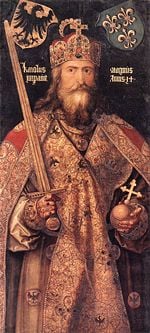
The Carolingian dynasty was a Frankish noble family with its origins in the Arnulfing and Pippinid clans of the seventh century. The name "Carolingian" itself comes from the Latin spelling of Charles Martel, (686-741)—Carolus Martellus—who defeated the Moors at the Battle of Tours in 732. The greatest Carolingian monarch was Charlemagne (742 or 747 to 814), a champion of Christianity and supporter of the papacy. Charlemagne fought the Slavs south of the Danube, annexed southern Germany, and subdued and converted pagan Saxons in the north-west. Charlemagne had himself crowned Emperor by Pope Leo III at Rome in 800, an event which revived the Roman imperial tradition in the west, and set a precedent for the dependence of the emperors on papal approval.
He is often seen as the Father of Europe and is an iconic figure, instrumental in defining European identity. His was the first truly imperial power in the West since the fall of Rome. Latin was the official language of the court and the Church, although the West Franks in Gaul adopted the Latinate vernacular that became French. East Franks and other Germanic people spoke various languages that became German. Carolingian rulers encouraged missionary work among the Germans. Non-Frankish Germans, however, retained much pagan belief beneath their newly acquired faith.
Empire divided
Charlemagne's third son Louis the Pious (778–840) was Emperor and King of the Franks from 814 to his death in 840. Under Frankish custom, all the king’s possessions, including the royal title, were divided among his sons, a practice that often resulted in civil war. The surviving adult Carolingians fought a three-year civil war ending in the Treaty of Verdun (843), which divided the empire among Charlemagne's three grandsons. One received West Francia (modern France), another acquired the imperial title and a territory extending from the North Sea to Italy, while the third, Louis the German (804-876), received East Francia (modern Germany). The Treaty of Mersen (870) divided the middle kingdom, with Lotharingia going to East Francia and the rest to West Francia. In 881, Charles the Fat (839-888) of East Francia, heir of Louis the German, received the imperial title. Six years later he was deposed by Arnulf of Carinthia (850-899), a bastard child of a legitimate Carolingian king, the last Carolingian emperor.
The Vikings and Normandy
Under the Carolingians, the kingdom was ravaged by Viking raiders. In this struggle some important figures such as Count Odo of Paris and his brother King Robert rose to fame and became kings. This emerging dynasty, called the Robertines, was the predecessor of the Capetian Dynasty, who were descended from the Robertines. Led by Rollo, the Vikings had settled in Normandy and were granted the land first as counts and then as dukes by King Charles the Simple. The people that emerged from the interactions between Vikings and the mix of Franks and Gallo-Romans became known as the Normans.
The Capetians
The Carolingians ruled France until 987, when Hugh Capet, Duke of France and Count of Paris, was crowned king. He was recorded to be recognized king by the Gauls, Bretons, Danes, Aquitanians, Goths, Spanish and Gascons. Hugh had his son Robert crowned, as Robert II in 996. His son, Henry, became King in 1031. The Capetians eventually passed the crown through a direct male line for more than three centuries, from 987 until 1328.
The French kingdom was very decentralized. If the king ventured outside of his own territory, he risked being captured by his vassals. In the late eleventh century, vassals William the Conqueror, Duke of Normandy, and Hugh the Great, abbot of Cluny, were more powerful than the Capetian King Philip I (who reigned 1060-1108).
Philip’s successor, Louis VI (who reigned 1108-1137), consolidated royal power in the Île-de-France, a region centering on Paris, by suppressing feudal opposition. In 1137, he arranged for his son, the future Louis VII, to marry Eleanor, heiress to the Duchy of Aquitaine, thereby gaining control of extensive territories between the River Loire and the Pyrenees Mountains. Louis VII was well served by a competent advisor, Abbot Suger, whose vision of construction became known as the Gothic Architecture during the later Renaissance.
But the marriage was not agreeable to Eleanor, adultery was alleged, and she had not produced a male heir, so the marriage was annulled 1152. Eleanor married Henry Plantagenet, Count of Anjou and Duke of Normandy, who in 1154 became King of England as Henry II. Aquitaine passed to the English Crown, and the regions controlled by Henry II in France (the Angevin Empire) exceeded those of his feudal lord, Louis VII.
Later Capetians
Philip II Augustus (1165-1223) was King of France from 1180 until his death. Philip was one of the most successful medieval French monarchs in expanding the royal demesne and the influence of the monarchy. He broke up the great Angevin Empire and defeated a coalition of his rivals at the Battle of Bouvines in 1214. He reorganized the government, bringing financial stability to the country and thus making possible a sharp increase in prosperity. His reign was popular with ordinary people because he checked the power of the nobles and passed some of it on to the growing middle class. Philip Augustus founded the Sorbonne university and made Paris a city of scholars.
His son Louis VIII led a successful campaign that resulted in the extension of the royal domain south to the coast of the Mediterranean Sea. Louis IX (1215–1270), commonly Saint Louis, was King of France from 1226 to his death, on a Crusade when he was struck down by disease and died while attacking Tunis. He is the only canonized king of France. He established the Parlement of Paris. Philip III (1245-1285), called "the Bold," was declared king at the age of 25 when his father died, and also died on a Crusade. He arranged for the marriage of his son to the heiress of Champagne, adding that county to royal possessions.
Philip IV (1268-1314), called "the Fair" was so powerful that he could name popes and emperors, unlike the early Capetians. Costly policies led him to try to tax the clergy, and this in turn brought him into sharp conflict with Pope Boniface VIII. In 1305, Philip secured the election of a French pope, Clement V. The papal court moved from Rome to Avignon in 1309, and Philip was cleared of any charges of impropriety in their dealings with Boniface. Philip strengthened the royal government, and was the first to summon the Estates-General, an assembly of the different classes of French subjects, but his high-handed methods lost public respect. His three sons -—Louis X, Philip V, and Charles IV—each held the throne successively, and all died without male heirs
Hundred Years' War
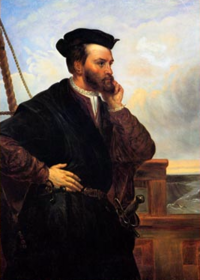
The Hundred Years' War was a conflict between France and England, lasting 116 years from 1337 to 1453. It was fought primarily over claims by the English kings to the French throne. On the death of Charles IV, the French crown passed to Philip IV’s nephew, Philip of Valois, who reigned as Philip VI from 1328 to 1350. The English King Edward II had married the daughter of Philip IV Isabella of France without succession problems, but her son Edward III (who reigned 1327-1377) put forward a claim in 1337 to the French throne as the legitimate grandson of Philip the Fair and the sole surviving male heir according to the law of primogeniture.
The Hundred Years' War was punctuated by several brief and two lengthy periods of peace before it finally ended in the expulsion of the English from France, with the exception of the Calais. Thus, the war was in fact a series of conflicts and is commonly divided into three or four phases: the Edwardian War (1337-1360), the Caroline War (1369-1389), the Lancastrian War (1415-1429), and the slow decline of English fortunes after the appearance of Joan of Arc. During this war, France evolved politically and militarily. Humiliating defeats of Poitiers (1356) and Agincourt (1415) forced the French nobility to realize they could not stand just as armored knights without an organized army. Charles VII established the first French standing army.
Black Death
The Black Death bubonic plague, one of the most deadly pandemics in human history, entered France via Marseille in 1348, and engulfed the country in two years, killing up to one-third of the population. The plague recurred in 1361, 1362, 1369, 1372, 1382, 1388, and 1398. Children were especially vulnerable. Obsession with death pervaded, and fanatical religious movements spread. Peasants caught between high prices, and landlords who tried to increase production and freeze wages rebelled, the most famous and widespread being the Jacquerie uprising of 1358. The Estates-General, the assembly of clergy, nobles, and commoners first summoned by Philip IV and used as a form for the king to present policy, gained in power.
Joan of Arc
Joan of Arc (Jeanne d'Arc) (1412-1431) was a fifteenth century national heroine of France. Joan asserted that she had visions from God which told her to recover her homeland from English domination late in the Hundred Years' War. The uncrowned Charles VII of France sent her to the siege at Orléans (1428-1429) as part of a relief mission. She gained prominence when she overcame the dismissive attitude of veteran commanders and lifted the siege in only nine days. Several more swift victories led to Charles VII's coronation at Reims and settled the disputed succession to the throne. A politically motivated trial convicted her of heresy and she was burnt at the stake when she was only 19 years old. The judgment was broken by the Pope and she was declared innocent and a martyr 24 years later.
Renaissance France
By 1500, France evolved from a feudal country to an increasingly centralized state organized around a powerful absolute monarchy that relied on the doctrine of the Divine Right of Kings and the explicit support of the established Church. The Renaissance writer François Rabelais (probably born in 1494) helped to shape the French language as a literary language. During the sixteenth century the French kingdom began to claim North American territories as colonies. Jacques Cartier was one of the great explorers who ventured deep into American territories during the sixteenth century. The largest group of French colonies became known as New France, and several cities such as Quebec City, Montreal, Detroit and New Orleans were founded by the French.
Francis I
Francis I (1494 - 1547), who is considered to be France's first Renaissance monarch, significantly increased both the power and the prestige of the Crown. He regarded himself as the monarchy’s sole lawmaker and never called the Estates-General. He was a patron of the arts and learning, and buildings surviving from his reign show the power and wealth of the monarchy. France engaged in the long Italian Wars (1494-1559), which marked the beginning of early modern France. Francis I was captured at Pavia in 1525 by the Holy Roman Emperor Charles V and later freed after granting concessions. The French monarchy allied with the Ottoman Empire. The Ottoman Admiral Barbarossa captured Nice in August 1543 and handed it down to Francis I.
During the sixteenth century, the Spanish and Austrian Habsburgs were the dominant power in Europe. Charles Quint, as Count of Burgundy, Holy Roman Emperor, King of Aragon, Castile and Germany (among many other titles) encircled France. The Spanish Tercio was used with great success against French knights and remained undefeated for a long time. Finally on January 7, 1558, the Duke of Guise seized Calais from the English.
The Reformation
Lutheranism was introduced in France after about 1520. Initially, King Francis I was tolerant of religious reformers, but after the Affair of the Placards in 1534, in which notices appeared in the streets denouncing the Papal Mass, he began to view Protestants as a threat and openly moved against them. One French Protestant, John Calvin (1509-1564), created the doctrine and the institutions of French Protestantism. He found refuge in Geneva, where he came to hold great influence on the reform movement. During the reign of Henry II (1547-1559), Calvinism gained numerous converts in France among the French nobility, the middle class, and the intelligentsia. Although Huguenots accounted for only a small fraction of the French population, the great wealth and influence that many of them possessed began to cause bitterness. In 1559, delegates from 66 Calvinist congregations in France met secretly at Paris in a national synod which drew up a confession of faith and a book of discipline. Thus was organized the first national Protestant church of France.
Wars of religion
The French Wars of Religion, (1562 to 1598) were a series of conflicts in France fought between Catholics and Huguenots (Protestants) from the middle of the sixteenth century to the Edict of Nantes in 1598, including civil infighting as well as military operations. In addition to the religious elements, they involved a struggle for control over the ruling of the country between the powerful House of Guise (Lorraine) and the Catholic League, on the one hand, and the House of Bourbon on the other.
Renewed Catholic reaction headed by the powerful duke of Guise, led to a massacre of Huguenots at Vassy in 1562, starting the first of the French Wars of Religion, during which English, German, and Spanish forces intervened on the side of rival Protestant and Catholic forces. In the most notorious incident, thousands of Huguenots were murdered in the St. Bartholomew's Day massacre of 1572. The Wars of Religion culminated in the War of the Three Henrys in which Henry III assassinated Henry de Guise, leader of the Spanish-backed Catholic league, and the king was murdered in return. Following this war Henry III of Navarre became king of France as Henry IV and enforced the Edict of Nantes (1598), which granted a degree of religious toleration to Protestants.
Louis XIII and Cardinal Richelieu
Religious conflicts resumed under Louis XIII (1601-1643) when Armand Jean du Plessis, Cardinal Richelieu (1585-1642), the effective ruler of France for 18 years from 1624, forced Protestants to disarm. This conflict ended in the Siege of La Rochelle (1627-1628), in which Protestants and their English supporters were defeated. The following Peace of Alais confirmed religious freedom yet dismantled the Protestant defenses.
As a result of Richelieu's work, Louis XIII became one of the first exemplars of an absolute monarch. Under Louis XIII, the French nobility was firmly kept in line behind their King, and the political and military privileges granted to the Huguenots by his father were retracted (while their religious freedoms were maintained). Richelieu had executed several eminent and dangerous nobles and demolished castles that could be used as centers of resistance to break the political power of the nobility. Richelieu divided the country into 30 new administrative districts and appointed a royal officer to control each.
Richelieu joined the Thirty Years War on the side of the Catholic Habsburgs in 1636 because it was the national interest, but imperial Habsburg forces invaded France, ravaged Champagne, and threatened Paris. Richelieu died in 1642 and was replaced by Mazarin, while Louis XIII died one year later and was succeeded by Louis XIV, then aged five years. The French forces won a decisive victory at Rocroi (1643), and the Spanish army was decimated. The Truce of Ulm (1647) and the Peace of Westphalia (1648) brought an end to the war.
Louis XIV
Louis XIV (1638-1715), known as Louis the Great or the Sun King, ruled as King of France and of Navarre from 1643, a few months before his fifth birthday, but did not assume actual personal control of the government until the death of his First Minister Jules Cardinal Mazarin, in 1661. Louis would remain on the throne till his death just prior to his 77th birthday in 1715. Louis established an absolute state structure early, with a number of councils to advise him and to carry out his instructions. He gave the potentially dangerous nobility ceremonial court positions, leaving them no time for political activity. The government's active promotion of commerce kept the wealthy bourgeoisie happy. The king could appoint bishops, thus keeping control of an obedient clergy, who provided the theological justification of the divine right of Louis XIV. Louis built a great palace at Versailles, patronized the arts, founded the Academy of Fine Arts and the French Academy in Rome, supported authors with pensions, appointed a superintendent of music to raise standards, and established the Academy of Science.
Louis’s minister for commerce and finance, Jean-Baptiste Colbert, subsidized industries, limited foreign competition, developed colonial markets for French traders, rebuilt the navy, and built roads, bridges, and canals. But the costs of Louis’s wars unraveled much of Colbert’s economic development. Then in 1685, Louis revoked the Edict of Nantes, prompting between 200,000 and 300,000 Huguenots to leave France, many of them skilled craftsmen, intellectuals, army officers whom France could not afford to lose.
Eighteenth century France
Louis XV (reigned 1715-1774) sought escape in pleasure, discredited the monarchy, and was so unpopular that his body was buried secretly. His grandson, Louis XVI (reigned 1774-1792), was weak-willed, and his young queen, Marie Antoinette, frivolous and extravagant. In the eighteenth century, France was the richest and most powerful nation on the Continent. French architecture, design, fashion, and taste were imitated through the Western world, while French political and social ideas influenced Europe and America. It was a period of great economic growth. The country's industrial revolution began in that century, when the France was the leading industrial power in the world.
But the income of urban laborers and artisans, was eroded by inflation, and peasants were heavily burdened by taxes, tithes, and feudal obligations. The tax system, which exempted the lands of the nobility and the clergy, deprived the government of a significant source of revenue, and put an unfair burden on the peasantry and the bourgeoisie.
Successive ministries tried to establish a balanced taxation system of all wealth, but were blocked by privileged groups and by the lack of support from the King. The nobility in the parliaments led opposition to royal initiatives, posing as defenders of public liberties, but were advocating a return to government by the aristocracy. The philosophes, French writers on political, social, and economic problems, led intellectual opposition, arguing that all people had certain natural rights-—life, liberty, and property—-and that governments existed to guarantee these rights.
The War of the Austrian Succession (1740-1748) and the Seven Years’ War (1756-1763), were costly. By 1763, France lost almost all of its vast colonial empire in America and in India. The Vente de la Louisiane Louisiana Purchase vastly enlarged the United States of America. In 1778, the French became involved in the American War of Independence, against Britain, hoping to recover lost colonies, but only managed to increased an already heavy national debt.
The French Revolution
The French Revolution (1789–1799) was a period of political and social upheaval in the political history of France and Europe as a whole, during which the French governmental structure, previously an absolute monarchy with feudal privileges for the aristocracy and Catholic clergy, underwent radical change to forms based on Enlightenment principles of republic, citizenship, and inalienable rights. These changes were accompanied by violent turmoil, including executions and repression during the Reign of Terror, and warfare involving every other major European power.
On June 17, 1789, the 1200 deputies elected to the Estates-General declared themselves the National Assembly of France. When the government tried to disperse the assembly by force, the people of Paris stormed of the Bastille, a symbol of the hated Ancien Regime, on July 14, 1789, and forced the king to accept the National Assembly. A peasant revolt spread across the country. The alarmed assembly, in an all-night session, on August 4-5, abolished all feudal dues and privileges, hereditary nobility, and titles.
From 1789 to 1791, the National Assembly confiscated the property of the Church, issued paper money, established a new provincial administrative and judicial system, centered on locally elected officials and judges, and adopted a constitution in 1791 which created a parliamentary government with an hereditary monarch and an assembly indirectly elected by tax-paying citizens.
Louis XVI was an unwilling constitutional monarch, and militants were determined to establish a French republic. An uprising overthrew the monarchy on August 10, 1792, a new constituent assembly was elected by universal male suffrage, and in September 1792 it established the First French Republic. The assembly, known as the National Convention, used the Committee of Public Safety to deal with the crisis created by defeats by Austria and Prussia, rebellion, food shortages, and disarray among government officials. The committee instituted the Reign of Terror to eliminate enemies and to gain control. King Louis XVIwas tried and executed in January 1793 and Queen Marie Antoinette in October.
Meanwhile, Sardinia, Austria, and Britain were still at war with France. In 1795, the National Convention adopted a constitution outlining a republic with executive power vested in a five-man Directory and legislative power divided between two houses, indirectly elected ensuring control by citizens with substantial property. The Directory governed France through four years. Stability was threatened by Royalists eager to restore the monarchy and by Jacobins wanting a democratic republic. A number of men in key positions backed the young general Napoleon Bonaparte who in November 1799, overthrew the Directory and established the Consulate.
Napoleon and the Empire
Napoleon Bonaparte (1769-1821) shaped a new constitution which placed all essential powers in the office he assumed, that of First Consul. Once in power, he forced Austria to make peace in 1801, and ended hostilities with Britain with the Treaty of Amiens (1802). He re-established the Roman Catholic Church as a state church. The Napoleonic code confirmed the abolition of feudal privileges, equality before the law, freedom of conscience, the individual’s free choice of occupation, and guarantees against arbitrary arrest and detention—all goals of the French Revolution. Napoleon placed control of the 83 administrative units set up by the National Assembly under a prefect appointed by the Ministry of the Interior. He established the Bank of France, created the franc as a new unit of currency, and organized the Imperial University to direct and control the nation’s teachers.
In 1804, Napoleon established the French Empire and crowned himself emperor, and in 1805, he went to war, defeating Austria, Prussia, and Russia. Britain controlled the seas after destroying the French fleet in 1805 off Cape Trafalgar, so Napoleon closed Europe to British trade. But his army was destroyed in Russia in 1812, and he was driven from Germany in 1813. He abdicated in April 1814 and surrendered to the allies. The allied rulers were convinced that restoration of the Bourbon monarchy would establish a peaceful France. In May the younger brother of the executed Louis XVI entered Paris as King Louis XVIII.
The new government was unpopular; the allies at the Congress of Vienna fell out as they tried to redraw the map of Europe. In March 1815, Napoleon escaped from exile on the island of Elba. The army backed him, Louis fled, and Napoleon re-established the empire, to be defeated on June 18, 1815, at Waterloo. Napoleon surrendered, and was imprisoned on the island of St Helena in the South Atlantic, where he died in 1821. Louis returned, and the Bourbon monarchy was restored.
Constitutional monarchy
The French monarchy was re-established, but with new constitutional limitations, the allied rulers imposed a military occupation of two-thirds of the country for five years, and required heavy indemnity payments. In a wave of revenge against Bonapartists and Republicans, scores were killed and hundreds wounded. The parliamentary elections in 1815 returned an ultra-Royalist chamber, which Louis dissolved. New elections brought moderate Royalists, economic productivity recovered, and the foreign occupation ended in 1818. The heir to the throne was assassinated in 1820, which led to the accession of ultra-Royalist Charles X (1757-1836) in 1824, who provided a stable government, enabling industry and commerce to thrive.
Revolutions of 1830 and 1848
An economic slowdown led to a political crisis, which in 1829 prompted Charles to dissolve the chamber. New elections confirmed an anti-Royalist majority, which Charles chose to defy. On July 26, 1830, he ordered new elections, with fewer voters, and press restrictions. Protests led to three days of street fighting. Charles abdicated and Louis Philippe, Duke of Orléans (1773-1850), was called to the throne as the last king of France. The king’s power to issue ordinances was eliminated, and the franchise was extended. Riots by disappointed Republicans and poor urban workers disrupted the regime of Louis Philippe, known as the July Monarchy, but it became firmly established by 1835.
Industrial production accelerated rapidly after 1840, and the migration from the country to urban areas mounted. From 1833, every commune in France was required to maintain a primary school for boys, free to those who could not afford to pay. But Louis Philippe resisted pressure to extend of the suffrage, and an economic depression in 1846 and 1847 undermined the regime’s support. In February 1848, a clash between troops and demonstrators turned into a revolution. Louis Philippe abdicated on February 24, and a group of Republican leaders proclaimed the Second French Republic.
Second Republic and Second Empire
Struggle between moderate and radical Republicans marked the first four months of the Second Republic, followed by three days of bloody street fighting in Paris known as the June Days. A constitution, adopted in November 1848, set up a presidential republic with a single assembly, based on universal male suffrage. Louis Napoleon Bonaparte (1808-1873), nephew of the former Emperor, won the presidency, while Monarchists hostile to the Republic dominated the assembly, making effective government difficult. Louis Napoleon seized power on December 2, 1851. One year later he restored the empire, and in 1852 took the imperial title of Napoleon III of France. The era saw great industrialization, urbanization (including the massive rebuilding of Paris by Baron Haussmann), and economic growth, but Napoleon III's foreign policies was not successful. Louis-Napoléon was unseated following defeat in the Franco-Prussian war of 1870, and his regime was replaced by the Third Republic.
The Third Republic and The Dreyfus Affair
In March, 1871, radical Republicans in Paris rebelled and set up the Commune of Paris, controlling the capital for two months until government troops recaptured the city. In 1875, Republicans won approval for a republican constitution. The Dreyfus affair was a political scandal which divided France from the 1890s to the early 1900s. It involved the wrongful conviction for treason of Captain Alfred Dreyfus, a promising young artillery officer in the French Army. Dreyfus was a Jew who had been born in the German-speaking Alsace that became part of the German Empire in 1871. The political and judicial scandal that followed lasted until Alfred Dreyfus was fully vindicated, after which he served in World War I as a lieutenant-colonel and was raised to the rank of Officer of the Legion of Honor.
World War I
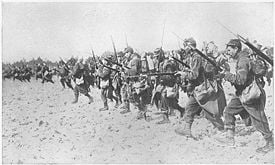
On June 28, 1914, Archduke Franz Ferdinand was murdered, triggering a chain of events causing the First World War. On August 3, the German Empire declared war to France and violated Belgium's neutrality, causing both France and Great-Britain to enter the war. Much of the war was fought on French territory. Though ultimately a victor, France suffered enormous human and material losses that weakened it for decades. About 1,394,000 men, 25 percent of all French men between the ages of 18 and 30, had been killed, and the north-eastern departments had been devastated. Peace terms were found in the Treaty of Versailles, largely negotiated by Georges Clemenceau (1841-1929) for French matters. Germany was required to take full responsibility for the war and to pay war reparations; and the German industrial Saarland, a coal and steel region, was occupied by France. The German African colonies were partitioned between France and Britain such as Cameroons, Alsace-Lorraine was returned to France.
After the war, the value of the franc dropped from 20 cents to 2 cents, hitting the bourgeoisie, the main supporters of the Republic, who relied on their savings. The Great Depression ended a brief interlude of prosperity and calm, followed by the resurgence after 1933, of a militant, aggressive Germany. In 1934, the Radical-Socialist, Socialist, and Communist parties joined in the Popular Front, winning control of the Chamber of Deputies in 1936. Léon Blum's Popular Front government dissolved Fascist organizations, establish paid holidays, a 40-hour week, and compulsory collective bargaining, before it fell apart in 1938 amid party quarrels and the threat of war.
World War II
On May 10, 1940, German forces invaded the Netherlands, Belgium, and France, and pushed through to the Channel coast, cutting off 45 French and British divisions, which were evacuated from Dunkirk to Britain. On June 22, the aged Marshal Philippe Pétain (1856-1951) surrendered to Germany. About two-thirds of French territory was occupied by German forces at French expense, while the Germans established a puppet regime under Pétain, known as Vichy France, which collaborated with Nazi Germany. Charles de Gaulle (1890-1970), a French general, built a small armed force and a shadow government in England, and was accepted by the Resistance movements inside France as the leader of a united opposition to Vichy and the Germans. On August 25, 1944, the Americans liberated Paris. De Gaulle organized a national provisional government, which he dominated for the next 15 months, until he stepped down in January 1946.
France during the Cold War
After a short period of provisional government initially led by General Charles de Gaulle, a new constitution (October 13, 1946) established the Fourth Republic under a parliamentary form of government controlled by a series of coalitions. During the following 16 years the French Colonial Empire would disintegrate. In Indochina the French government was facing the Viet Minh, socialist rebels, and lost its Indochinese colonies during the First Indochina War after the Battle of Dien Bien Phu. Vietnam was divided in two states while Cambodge and Laos were made independent. The May 1958 seizure of power in Algiers by French army units and French settlers opposed to concessions in the face of Arab nationalist insurrection led to the fall of the French government and a presidential invitation to de Gaulle to form an emergency government to forestall the threat of civil war. In May 1968, students revolted, with a variety of demands including educational, labor and governmental reforms, sexual and artistic freedom, and the end of the Vietnam War. The student protest movement quickly joined with labor and mass strikes erupted.
The new world order
While France continues to revere its rich history and independence, French leaders increasingly tie the future of France to the continued development of the European Union. Jacques Chirac assumed office as president on May 17, 1995, after a campaign focused on the need to combat France's high unemployment rate. The French have stood among the strongest supporters of NATO and EU policy in the Balkans, in order to prevent genocide in Yugoslavia, it contributed to the toppling of the Taliban-regime in Afghanistan in 2002, but it strongly rejected the 2003 invasion of Iraq. Jacques Chirac was re-elected in 2002, mainly because his socialist rival Lionel Jospin was defeated by the extreme right wing candidate Jean-Marie Le Pen. At the end of his second term he chose not to run again at the age of 74. His former protege, cabinet minster and rival Nicolas Sarkozy was elected as his successor and took office on May 16, 2007. The problem of high unemployment was yet to be resolved.
Government and politics
Constitutional structure
The French Republic is a unitary semi-presidential republic with strong democratic traditions. The constitution of the Fifth Republic was approved by referendum on September 28, 1958. It greatly strengthened the authority of the executive in relation to parliament.
The president is the chief of state and is elected by popular vote for a five-year term (formerly seven years). An election was held in April and May of 2007. The prime minister is nominated by a national assembly majority and appointed by the president. A council of ministers appointed by the president at the suggestion of the prime minister.
The French parliament is a bicameral legislature comprising a national assembly (Assemblée Nationale) and a senate. The 577 national assembly deputies (555 for metropolitan France, 15 for overseas departments, and seven for dependencies) are elected by popular vote under a single-member majority system to serve five-year terms. The assembly has the power to dismiss the cabinet, and thus the majority in the Assembly determines the choice of government.
The 331 senators (305 for metropolitan France, nine for overseas departments, five for dependencies, and 12 for French nationals abroad) are indirectly elected by an electoral college to serve nine-year terms, with one third elected every three years. The Senate's legislative powers are limited; in the event of disagreement between the two chambers, the National Assembly has the final say, except for constitutional laws and lois organiques (laws that are directly provided for by the constitution) in some cases. The government has a strong influence in shaping the agenda of Parliament.
Suffrage is universal for those aged 18 and over. French politics are characterized by two politically opposed groupings: one left-wing, centered around the French Socialist Party, and the other right-wing, centered previously around the Rally for the Republic(RPR)]] and now its successor the Union for a Popular Movement. The executive branch was composed mostly of the UPM in 2007.
The judiciary consists of Supreme Court of Appeals (Cour de Cassation), the judges of which are appointed by the president from nominations of the High Council of the Judiciary, a Constitutional Council with three members appointed by the president, three appointed by the president of the National Assembly, and three appointed by the president of the Senate, and the Council of State.
Law
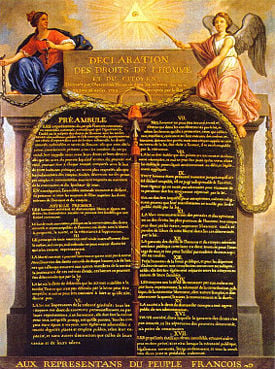
France uses a civil legal system, which is law arising from written statutes; judges are not to make law, but merely to interpret it (though the amount of judicial interpretation in certain areas makes it equivalent to case law). Basic principles of the rule of law were laid in the Napoleonic Code. In agreement with the principles of the Declaration of the Rights of Man and of the Citizen law should only prohibit actions detrimental to society. French law is divided into private law, which includes civil law and criminal law, and public law, which includes administrative law and constitutional law. France does not recognize religious law, nor does it recognize religious beliefs or morality as a motivation for the enactment of prohibitions. As a consequence, France has long had neither blasphemy laws nor sodomy laws (the latter being abolished in 1791). However "offenses against public decency" or breach of the peace have been used to repress public expressions of homosexuality or street prostitution.
Foreign relations
France is a member of the United Nations and serves as one of the permanent members of the U.N. Security Council with veto rights. It is also a member of the World Trade Organization, the Secretariat of the Pacific Community (SPC), the Indian Ocean Commission (COI). It is an associate member of the Association of Caribbean States (ACS) and a leading member of the International Francophone Organisation (OIF) of 51 fully or partly French-speaking countries. It hosts the headquarters of the OECD, UNESCO, Interpol, Alliance Base and the International Bureau for Weights and Measures.
French foreign policy has been largely shaped by membership of the European Union, of which it was a founding member. In the 1960s, France sought to exclude the British from the organization, seeking to build its own standing in continental Europe. Since the 1990s, France has developed close ties with reunified Germany to become the most influential driving force of the EU, but consequently rivaling the U.K. and limiting the influence of newly-inducted East European nations. France is a member of the North Atlantic Treaty Organization, but under President de Gaulle, it excluded itself from the joint military command to avoid the supposed domination of its foreign and security policies by U.S. political and military influence. In the early 1990s, the country drew considerable criticism from other nations for its atmospheric nuclear tests in Polynesia. France vigorously opposed the 2003 invasion of Iraq, straining bilateral relations with the U.S. and the U.K. France retains strong political and economic influence in its former African colonies (Francophone) and has supplied economic aid and troops for peace-keeping missions in the Cote d'Ivoire and Chad.
Military
The French armed forces comprises an army, navy, air force, and French Gendarmerie, a military force which acts as a National Rural Police and as a Military police for the entire French military. Conscription was suspended in 2001. The total number of military personnel is approximately 359,000. France spends 2.6 percent of its GDP on defense, slightly more than the United Kingdom (2.4 percent), and is the highest in the European Union. About 10 percent of France's defense budget goes towards its nuclear weapons. A significant part of French military equipment is made in France, including the Rafale fighter, the Charles de Gaulle aircraft carrier, the Exocet missile, and the Leclerc tank.
The French nuclear force consisted, in 2007, of four submarines equipped with M45 ballistic missiles. The French dissuasion force uses the Mirage 2000N; it is a variant of the Mirage 2000 and thus is designed to deliver nuclear strikes. Other nuclear devices like the Plateau d'Albion's Intercontinental ballistic missiles and the short range Hadès missiles have been disarmed. With 350 nuclear heads stockpiled France is the world's third largest nuclear power.
Administrative divisions
France is divided into 26 administrative regions. Twenty two are in metropolitan France (21 are on the continental part of metropolitan France; one is the territorial collectivity of Corsica), and four are overseas regions. The regions are further subdivided into 100 departments which are numbered (mainly alphabetically). This number is used in postal codes and vehicle number plates amongst others. The 100 departments are subdivided into 341 arrondissements which are, in turn, subdivided into 4032 cantons. These cantons are then divided into 36,680 communes, which are municipalities with an elected municipal council. Three communes, Paris, Lyon and Marseille are also subdivided into 45 municipal arrondissements.
The regions, departments and communes are all known as territorial collectivities, meaning they possess local assemblies as well as an executive. Arrondissements and cantons are merely administrative divisions.
The French Republic also has six overseas collectivities, one sui generis collectivity (New Caledonia), and one overseas territory. Overseas collectivities and territories form part of the French Republic, but do not form part of the European Union or its fiscal area. The Pacific territories continue to use the Pacific franc whose value is linked to that of the euro. In contrast, the four overseas regions used the French franc and now use the euro.
France also maintains control over a number of small non-permanently inhabited islands in the Indian Ocean and the Pacific Ocean: Bassas da India, Clipperton Island, Europa Island, Glorioso Islands, Juan de Nova Island, and Tromelin Island. Overseas departments have the same political status as metropolitan departments. They include Guadeloupe, Martinique, French Guiana, and Réunion, all since 1946.
Marianne
Marianne is a symbol of the French Republic. She is an allegorical figure of liberty and the Republic and first appeared at the time of the French Revolution. The earliest representations of Marianne are of a woman wearing a Phrygian cap. The origins of the name Marianne are unknown, but Marie-Anne was a common first name in the eighteenth century. Anti-revolutionaries of the time derisively called her La Gueuse (the Commoner). It is believed that revolutionaries from the South of France adopted the Phrygian cap as it symbolized liberty, having been worn by freed slaves in both Greece and Rome. Mediterranean seamen and convicts manning the galleys also wore a similar type of cap.
Economy
After the Second World War, France embarked on an ambitious program of modernization, known as dirigisme. Mostly implemented by socialist governments, it involved the state control of industry, such as transportation, energy and telecommunications infrastructures. However, dirigisme came to be highly contested after 1981 when newly elected socialist president François Mitterrand called for increased governmental control in the economy, nationalizing many industries and private banks. By 1983, with the initial bad economic results the government decided to renounce dirigisme and start the era of rigueur ("rigour") or "corporatization."
France, in 2007, was in the midst of transition from a well-to-do modern economy that has featured extensive government ownership and intervention to one that relies more on market mechanisms. The government has partially or fully privatized many large companies, banks, and insurers, and has ceded stakes in such leading firms as Air France, France Telecom, Renault, and Thales. It maintains a strong presence in some sectors, particularly power, public transport, and defense industries. The telecommunications sector is gradually being opened to competition.
France's leaders remained committed to a capitalism in which tax policies and social spending reduce income disparity. The government in 2006 focused on introducing measures that attempt to boost employment through increased labor market flexibility; however, the population has remained opposed to labor reforms.
The tax burden remained one of the highest in Europe (nearly 50 percent of GDP in 2005). The lingering economic slowdown and inflexible budget items probably pushed the budget deficit above the eurozone's three percent-of-GDP limit in 2006; unemployment hovers near nine percent. With at least 75 million foreign tourists per year, France is the most visited country in the world and maintains the third largest income in the world from tourism.
Legislation passed in 1998 shortened the legal workweek from 39 to 35 hours. A key objective was to encourage job creation, for which significant new subsidies were to be made available.
Membership in France's laboor unions accounted for less than 10 percent of the private sector workforce and is concentrated in the education, manufacturing, transportation, and heavy industry sectors. Most unions are affiliated with one of the competing national federations, the largest and most powerful of which are the CGT, FO, and CFDT. French unions are fairly weak, and strikes are uncommon in most of the economy. Nonetheless, unions are powerful in some parts of the public sector, particularly public transportation (SNCF national railways, RATP Paris transit authority and air traffic control), where strikes attract the attention of the national and foreign press.
A member of the G8 group of leading industrialized countries, it is ranked as the sixth largest economy in the world in 2005, behind the United States, Japan, Germany, The People's Republic of China and the United Kingdom. France joined 11 other EU members to launch the Euro on January 1, 1999, with euro coins and banknotes replacing the French franc (₣) in early 2002.
In the 2005 edition of OECD in Figures, the OECD noted that France led the G7 countries in terms of productivity (measured as GDP per hour worked). In 2004, the GDP per hour worked in France was $47.7, ranking France above the United States ($46.3), Germany ($42.1), the United Kingdom ($39.6), or Japan ($32.5). But France's GDP per capita is significantly lower than the US GDP per capita. The reason for this is that a much smaller percentage of the French population is working compared to the US, which lowers the GDP per capita of France, despite its higher productivity. In fact, France has one of the lowest percentages of its population aged 15-64 years at work among the OECD countries. In 2004, 68.8 percent of the French population aged 15-64 years was in employment, compared to 80 percent in Japan, 78.9 percent in the UK, 77.2 percent in the US, and 71 percent in Germany.
France has an important aerospace industry led by the European consortium Airbus, and is the only European power (excluding Russia) to have its own national spaceport, (Centre Spatial Guyanais). France is also the most energy independent Western country due to heavy investment in nuclear power, which also makes France the smallest producer of carbon dioxide among the seven most industrialized countries in the world. As a result of large investments in nuclear technology, most of the electricity produced in the country is generated by nuclear power plants (78.1 percent in 2006, up from only eight percent in 1973.
Large tracts of fertile land, the application of modern technology, and EU subsidies have combined to make France the leading agricultural producer and exporter in Europe. Wheat, poultry, dairy, beef, and pork, as well as an internationally recognized foodstuff and wine industry are primary French agricultural exports. EU agriculture subsidies to France total almost $14-billion.
Exports totaled $483.1-billion in 2006. Export commodities included machinery and transportation equipment, aircraft, plastics, chemicals, pharmaceutical products, iron and steel, and beverages. Export partners included Germany 15.6 percent, Spain 9.6 percent, Italy 8.9 percent, the UK 8.2 percent, Belgium 7.2 percent, the US 6.7 percent, Netherlands 4 percent.
Imports totaled $520.8-billion in 2006. Import commodities included machinery and equipment, vehicles, crude oil, aircraft, plastics, and chemicals. Import partners included Germany 19 percent, Belgium 11 percent, Italy 8.3 percent, Spain 7 percent, Netherlands 6.7 percent, UK 6.5 percent, US 4.6 percent.
The GDP per_capita was $35,404 in 2006, a rank of 18 out of 194 countries. The unemployment rate was 8.7 percent in 2006, and 6.2 percent of the population existed below the poverty line in 2004.
Demography
Population
With a total population of just over 67 million people, with 65 million in metropolitan France, France is the 20th most populous country in the world and the third-most populous in Europe. France is also second most populous country in the European Union after Germany.
France is an outlier among developed countries in general, and European countries in particular, in having a fairly high rate of natural population growth. Immigrants are also major contributors to this trend.
Ethnicity
Since the beginning of the Third Republic (1871-1940), the state has not categorized people according to their alleged ethnic origins, to prevent discrimination. The French Constitution holds that "French" is a nationality, and not a specific ethnicity. France is an ethnically diverse nation, including people of Celtic, Latin, Teutonic, Slavic, North African, Indochinese ancestry, as well as Basque minorities. Conflict between the government and regional groups including Corsicans, Bretons, and Basques escalated toward the end of the twentieth century, with a heightened push for political autonomy.
Religion
France is a secular country where freedom of thought and of religion are preserved, in virtue of the 1789 Declaration of the Rights of Man and of the Citizen. The Republic is based on the principle of laïcité, that is of freedom of religion (including agnosticism and atheism) enforced by the 1880s Jules Ferry laws and the 1905 French law on the separation of church and state. Not until 1993 did France outlaw polygamy. The French government is legally prohibited from recognizing any religion. Instead, it merely recognizes religious organizations, according to formal legal criteria that do not address religious doctrine. Conversely, religious organizations are expected to refrain from intervening in policy-making. Tensions occasionally erupt into violence about alleged discrimination against minorities, especially against Muslims.
Roman Catholicism, the religion of up to 88 percent of the French people, is no longer considered a state religion, as it was before the 1789 Revolution and throughout the various, non-republican regimes of the nineteenth century (the Restauration, the July Monarchy and the Second Empire).
According to a January 2007 poll by the Catholic World News: 51 percent identified as being Catholics, 31 percent identified as being agnostics or atheists. (Another poll concluded that 27 percent identified as being atheists), ten percent identified as being from "other religions" or being without opinion, 4 percent identified as Muslim, 3 percent identified as Protestant, 1 percent identified as Jewish.
The current Jewish community in France numbers around 600,000 according to the World Jewish Congress and is largest in Europe. Estimates of the number of Muslims in France vary widely. According to the 1999 French census returns, there were only 3.7 million people of "possible Muslim faith" in France (6.3 percent of the total population).
There are an estimated 200,000 to 1 million illegal immigrants in France.
Language
French is a Romance language originally spoken in France, Belgium, Luxembourg, and Switzerland, and today by about 300 million people around the world as either a native or a second language. French is a descendant of the Latin of the Roman Empire, as are languages such as Spanish, Italian, Catalan, Romanian, and Portuguese. Its development was also influenced by the native Celtic languages of Roman Gaul and by the Germanic language of the post-Roman Frankish invaders. It is an official language in 29 countries, most of which form what is called in French La Francophonie, (Frankophone) the community of French-speaking nations, and is an official language of all United Nations agencies. France has two linguistic regions: that of the langue d'oeil to the north and that of the langue d'oc to the south.
According to Article 2 of the Constitution, French is the sole official language of France since 1992. This makes France the only Western European nation (excluding microstates) to have only one officially recognized language. However, 77 regional languages are also spoken, in metropolitan France as well as in the overseas departments and territories. These include Breton, Catalan, Corsican, Basque, Alsatian, and Flemish. The French government and state school system discouraged the use of any of these languages, but they are now taught to varying degrees at some schools. Other languages, such as Portuguese, Italian, Maghrebi Arabic and several Berber languages are spoken by immigrants.
L'Académie française, or the French Academy, is the pre-eminent French learned body on matters pertaining to the French language. The Académie was officially established in 1635 by Cardinal Richelieu, the chief minister to King Louis XIII. It was suppressed in 1793 during the French Revolution, and was restored in 1803 by Napoleon Bonaparte. It is the oldest of the five académies of the Institut de France. The Académie consists of 40 members, known as immortals (immortals). New members are elected by the members of the Académie. Académicians hold office for life, but they may be removed for misconduct. The Academy publishes an official dictionary.
Men and women
Traditionally, in peasant households, women carried out the domestic tasks of housekeeping, food preparation, and child care. With industrialization, women worked outside the home as washerwomen, factory workers, and domestics. By the end of the twentieth century, almost half of all workers were female and the dual-career family was normal. However, women continued to face lower wages than men for comparable work and more difficult career paths. Women did not gain the right to vote until 1944, and it was only in the 1960s that wives gained the right to open bank accounts or work without the husband's permission.
Marriage and the family
The marriage rate was declining in 2007, the average age of marriage for men was 29, and that for women 27. Most marriages involve partners from the same area, and mostly from the same religion. The Socialist government of the 1980s, under a policy called "family reunification" opened the way for polygamy, by allowing immigrants to bring their extended families into France legally. Polygamy was outlawed in 1993, but as many as 150,000 to 400,000 families, many from Mali, remain in polygamous or "semi-polygamous" family situations. Generous benefits from the government in some cases may be financially supporting 20 or more members of a single family, when a husband has multiple wives and dozens of children. In recent years, one in three marriages ends in divorce. All marriages have a civil ceremony in the town hall, and many are followed by a religious ceremony. Payment for the weddings is divided equally between both families. Cohabitation of unmarried couples has increased. A law, passed in 1999, set up an intermediate union between marriage and cohabitation, including homosexual couples, which is easier to dissolve than a marriage.
The basic domestic unit is called le ménage, which includes all persons living in the same dwelling, and who are not necessarily related. In 1997, most households consisted of couples with (35 percent) or without (28 percent) children. Single women made up 18 percent of all households, and 12 percent of single men. The nuclear family was most prevalent in southern France, and is where a young couple is established in their own household by both sets of parents. The patriarchal family prevailed in rural areas of central France, where siblings stayed at home, with their spouses, and owned property jointly, as did the stem family, where the eldest son would remain in the family home, while other siblings had to seek their fortunes elsewhere. That pattern persists in some country areas, although primogeniture has been illegal since 1804. The family continues to play a key role in transmitting cultural values.
Education
The French educational system is highly centralized, and is divided into three different stages: primary, secondary, and higher education. Primary and secondary education is predominantly public (private schools also exist, in particular a strong nationwide network of primary and secondary Catholic schools), while higher education has both public and private elements.
While the French trace the development of their educational system to Charlemagne, the modern era of French education begins at the end of the nineteenth century. Jules Ferry, a lawyer holding the office of Minister of Public Instruction in the 1880s, is widely credited for creating the modern Republican school by requiring all children under the age of 15—boys and girls—to attend. He also made public instruction free of charge and secular.
The teachers in public primary and secondary schools are all state civil servants, making the ministère the largest employer in the country. Professors and researchers in France's universities are also employed by the state. At the primary and secondary levels, the curriculum is the same for all French students in any given grade, which includes public, semi-public and subsidized institutions. However, there exist specialized sections and a variety of options that students can choose.
Higher education in France is divided into grandes écoles and universities. Grandes écoles are considered more prestigious than universities. For example in France most prestigious engineering Grandes École, École polytechnique have about 12,000 applicants for 400 places. A striking trait of French higher education, in contrast with other countries, is the small size and multiplicity of establishments, each specialized in a more or less broad spectrum of disciplines.
In 2003, 99 percent of the population over the age of 15 could read and write.
Class
Historically, France was divided among the nobility, the bourgeoisie, the peasants, and the urban proletariat, providing the basis for much of Karl Marx's nineteenth century analysis of class struggle. The modern social structure, which started in the late 1950s, is based on three distinct classes. There are the high level politicians, the wealthy families and the also powerful business owners. The middle class group comprises two different types of white-collar jobs—senior executives, and those in high-income, stable, professional jobs. The lower class comprises blue-collar workers in food-service jobs or retail. Unemployment and the low living standards are common in this group. The number of blue-collar jobs has decreased while the civil service section has steadily increased. Children tend to remain in the occupational class of their parents, a situation attributed to the school system. Symbols of a higher class position include knowing about fine art and the newest trends, appreciating and being able to afford fine wines, and dressing with understatement. Wealth and family connections and lifestyle determine social position.
Culture
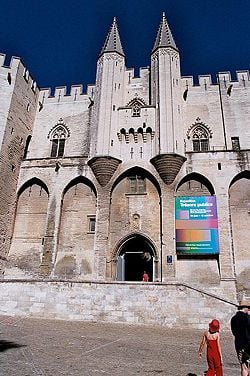
Architecture
Although there is no architecture named French Architecture, Gothic Architecture's old name was French Architecture (or Opus Francigenum). Northern France is the home of some of the most important Gothic cathedrals and basilicas, the first of these being the Saint Denis Basilica (used as the royal necropolis); other majestic and important French Gothic cathedrals are Notre-Dame de Chartres and Notre-Dame d'Amiens. The kings were crowned in another important Gothic church: Notre-Dame de Reims, and French popes lived in the Gothic Palais des Papes in Avignon.
During the Middle Ages, fortified cities were common, as were fortified castles built by feudal nobles to mark their power. Some important French castles that survived are Chinon Castle, Château d'Angers, the massive Château de Vincennes, and the so-called Cathar castles. Romanesque architecture which used Mooresque architecture prevailed before the rise of the Gothic style. Romanesque churches in France include the Saint Sernin Basilica in Toulouse and the remains of the Cluniac Abbey (largely destroyed during the Revolution and the Napoleonic Wars).
The end of the Hundred Years' War marked the French Renaissance. Numerous Italian-inspired residential palaces were built, mainly in the Loire Valley, including the Château de Chambord, the Château de Chenonceau, or the Château d'Amboise. Following the Renaissance and the end of the Middle Ages, Baroque Architecture replaced Gothic. The Palace of Versailles has many baroque features. Jules Hardouin Mansart can be said to be the most influential French architect of the baroque style, with his very famous baroque dome of Les Invalides.
Neoclassicism was introduced before the revolution with such buildings as the Parisian Pantheon and the Capitole de Toulouse. Built during the French Empire the Arc de Triomphe and Sainte Marie-Madeleine represent this trend the best.
Under Napoleon III (1808-1873) a new wave of architecture appeared, including the neo-baroque Palais Garnier. The urban planing of the time was organized and rigorous, such as Baron Haussmann's renovation of Paris. In the late nineteenth century Gustave Eiffel designed many bridges (like the Garabit viaduct) and remains one of the most influential bridge designer of his time, although he is best remembered for the Eiffel Tower.
In the twentieth century the Swiss Architect Le Corbusier designed several buildings in France. More recently French architects have combined both modern and old architectural styles. The Louvre Pyramid of I.M. Pei is a good example of modern architecture added to an older building. France's largest financial district La Defense has a significant number of skyscrapers.
Art
The first paintings of France are those that are from prehistoric times, painted in the caves of Lascaux well over 10,000 years ago. The arts flourished already 1200 years ago, at the time of Charlemagne, as can be seen in many hand made and hand illustrated books of that time. Classic painters of seventeenth century France are Nicolas Poussin and Claude Lorrain. During the eighteenth century, the Rococo style emerged as a frivolous continuation of the Baroque style. The most famous painters of the era were Antoine Watteau, François Boucher and Jean-Honoré Fragonard. At the end of the century, Jacques-Louis David was the most influential painter of the Neoclassicism.
Géricault and Delacroix were the most important painters of the Romanticism. The realistic movement was led by Courbet and Honoré Daumier. Impressionism was developed in France by artists such as Claude Monet, Edgar Degas, Pierre-Auguste Renoir and Camille Pissarro. At the turn of the century, France had become the center of innovative art. The Spaniard Pablo Picasso came to France, like many other foreign artists, to deploy his talents there for decades to come. Toulouse-Lautrec, Gauguin and Cézanne were painting then. Cubism is an avant-garde movement born in Paris at the beginning of the twentieth century.
The Louvre in Paris is one of the most famous and the largest art museums in the world, created by the new revolutionary regime in 1793 in the former royal palace. It holds a vast amount of art of French and other artists, including the Mona Lisa, by Leonardo da Vinci, and classical Greek Venus de Milo and ancient works of culture and art from Egypt and the Middle East.
Cinema
Auguste and Louis Lumière invented the cinématographe, and their screening of L'Arrivée d'un train en gare de la Ciotat in Paris in 1895 is marked by many historians as the official birth of cinematography. During the next few years, France's Georges Méliès invented many common cinematic techniques, and made the first ever science fiction film A Trip to the Moon (1902). Alice Guy Blaché made her first film in 1896, La Fée aux Choux, and was head of production at Gaumont 1897-1906, where she made in total about 400 films. Her career continued in the United States.
During the period between World War I and World War II, Jacques Feyder became one of the founders of poetic realism in French cinema. He was also a dominating character within French Impressionist Cinema. The French film industry suffered from a lack of investment after the First World War, creating an opportunity for the US film industry to enter the European cinema market with their own films, which could be sold cheaper than the European productions. A quota system was introduced to protect French cinema.
In 1937, Jean Renoir, the son of famous painter Pierre-Auguste Renoir, directed what many see as his first masterpiece, La Grande Illusion (The Grand Illusion). In 1939 Renoir directed La Règle du Jeu (The Rules of the Game).
Modern film theory was born in the critical magazine Cahiers du cinéma, founded by André Bazin, in which critics and lovers of film would discuss film and why it worked. Cahiers critics such as Jean-Luc Godard, François Truffaut, and Claude Chabrol, went on to make films themselves, creating what was to become known as the French New Wave. Some of the first movies of this new genre was Godard's Breathless (À bout de souffle, 1960), starring Jean-Paul Belmondo and - the leading movie - Truffaut's The 400 Blows (Les Quatre Cent Coups, 1959) starring Jean-Pierre Léaud.
Cuisine
see also French Cuisine
French cuisine is considered to be one of the world's most refined styles of cooking that evolved over the centuries. The Middle Ages brought lavish banquets to the upper class with ornate, heavily seasoned food prepared by chefs such as Guillaume Tirel. The era of the French Revolution, however, saw a move toward fewer spices and more liberal use of herbs and refined techniques, beginning with François Pierre La Varenne and further developing with the famous chef of Napoleon Bonaparte and other dignitaries, Marie-Antoine Carême.
French cuisine was codified in the twentieth century by Georges Auguste Escoffier to become the modern version of haute cuisine. Escoffier's major work, however, left out much of the regional character to be found in the provinces of France. Gastro-tourism and the Guide Michelin helped to bring people to the countryside during the twentieth century and beyond, to sample this rich bourgeois and peasant cuisine of France. Basque cuisine has also been a great influence over the cuisine in the southwest of France.
Literature
French literature tracks its origins back to the Middle Ages, when French was divided into several dialects. Each writer used his own spelling and grammar. Several French medieval texts are not signed—such is the case with Tristan and Iseult, or with Lancelot and the Holy Grail, among many others. A significant part of medieval French poetry and literature was inspired by the Matter of France, such as the The Song of Roland and the various Chansons de geste. The Song of Roland was written in 1175 by Perrout de Saint Cloude, and told the story of the medieval character Reynard (the Fox); it is also a popular example of early French story-telling.
In spite of the anonymous character of many French writings of the Middle-Ages, some medieval writers became quite famous: Chrétien de Troyes, for instance. Occitan culture was also quite influent in the Middle Ages. An early example of a vernacular poet writing in Occitan was Duke William IX of Aquitaine.
One of the most important writers is François Rabelais (1494-1553), whose style contributed much to modern French. His most famous work is Gargantua and Pantagruel. Later on, Jean de La Fontaine wrote his famous Fables, a collection of short stories, written in verse, and usually ending with a "moral teaching."
But it is most certainly in the eighteenth and nineteenth centuries which French literature and poetry reached its highest point. The eighteenth century saw the writings of such huge writers, essayists and moralists as Voltaire, Denis Diderot and Jean-Jacques Rousseau. As concerns French children's literature in those times, Charles Perrault was probably the most prolific writer, with stories such as: Puss in Boots, Cinderella, Sleeping Beauty, and Bluebeard.
The nineteenth century saw the birth of many French novelists of world renown; Victor Hugo, Alexandre Dumas and Jules Verne are probably among the most famous among these writers, both in and outside of France, with such highly popular novels such as The Three Musketeers, The Count of Monte-Cristo, Twenty Thousand Leagues Under the Sea, or The Hunchback of Notre-Dame. Other nineteenth century fiction writers include Emile Zola, Guy de Maupassant, Théophile Gautier and Stendhal.
Symbolist poetry of the turn of the nineteenth century also proved to be a strong movement in French poetry, with artists such as Charles Baudelaire, Paul Verlaine and Stéphane Mallarmé. Writers Louis-Ferdinand Céline and Albert Camus have become famous outside of France. One of the most well-known twentieth century writers is Antoine de St.-Exupéry, whose Little Princehas been translated and become a bestseller in a great many countries, remaining popular both with children and adults. Nowadays, the Prix Goncourt (first given in 1903) rewards "the best and most imaginative prose work of the year." It has quite probably become France's best-known contemporary literary award.
Music
French music history dates back to organum, an early form of polyphonic singing, in the tenth century. Troubadour songs of chivalry and courtly love were composed in the Occitan language between the tenth and thirteenth centuries, and the Trouvère poet-composers flourished in Northern France during this period. By the end of the twelfth century, a form of song called the motet arose, accompanied by traveling musicians called jongleurs. In the fourteenth century, France produced two notable styles of music, Ars Nova and Ars Subtilior. During the Renaissance, Burgundy became a major center for musical development. This was followed by the rise of chansons and the Burgundian School.
France has a wide variety of indigenous folk music. In the West of France, traditions of ballad-singing, dance-songs and fiddle-playing have survived. Folk dances specific to the West of France include the courante, or maraichine, and the bal saintongeais. Circle- or chain-dances accompanied by caller-and-response singing have been noted. Central France is the home to the French bagpipe tradition, as well as the iconic hurdy gurdy and the dance bourrée. The hurdy gurdy, or vielle-à-roue, is essentially a mechanical violin, with keys or buttons instead of a finger board.
The main form of Basque folk music is called trikitixa, which is based on the accordion and includes popular performers like Benat Achiary and Oldarra. Corsican polyphonic singing is unique. Sung by male trios, it is strongly harmonic and occasionally dissonant. Works can be either spiritual or secular. Corsican musical instruments include the bagpipe (caramusa), 16-stringed lute (cetera), mandolin, fife (pifana) and the diatonic accordion (urganettu). The most popular form of the distinctly CelticBreton folk is the bagad pipe band, which features native instruments like biniou and bombarde alongside drums and, in more modern groups, biniou braz pipes.
The first French opera may be Akébar roi du Mogol, first performed in Carpentras in 1646. It was followed by the team of Pierre Perrin and Cambert, whose Pastoral in Music, performed in Issy, was a success, and the pair moved to Paris to produce Pomone (1671) and Les Peines et les Plaisirs de l'Amour (1672).
One of the major French composers of the early Romantic era, was Hector Berlioz. In the late nineteenth century, pioneers like Georges Bizet, Jules Massenet, Gabriel Fauré, Maurice Ravel and Claude Debussy revitalized French music, and influenced composers like Béla Bartók and Igor Stravinsky.
At the end of World War ll, French musicians were becoming experimental and diverse. Popular musicians from the era included romantic vocalists like Édith Piaf, politicized singers like Leo Ferre, morbid sex symbols like Juliette Greco, elegant stars like Charles Aznavour and experimental, often humorous, performers like Georges Brassens and the Belgian Jacques Brel.
Philosophy
French philosophy has been extremely diverse and influential. Michel Eyquem de Montaigne (1533-1592) is noted for his anti-dogmatic stances which made him the father of the anti-conformist French spirit. He was the first person to use the word essays, and his writings came to be highly influential upon Shakespeare, Rousseau and Nietzsche. His radical skepticism, summed up in the phrase Que sais-je? served as one of the catalysts for René Descartes' work. René Descartes (1596-1650) changed the primary object of philosophical thought from ontology to epistemology. Voltaire (1694-1778) came to embody the Enlightenment with his criticisms of Church dogma and French institutions, his defense of civil liberties and his support of social reform.
Jean-Jacques Rousseau (1712-1778) distinguished himself from the progressive scientism of the Enlightenment with his proclamation that art and science are corruptors of human morality. Denis Diderot (1713-1784) was a key collaborator in the creation of the Encyclopédia, a systematic collection of all the information of the arts and sciences that caused great controversy.
Henri Bergson (1859-1941) was somewhat of a celebrity. All of Henri Bergson’s works were concerned with his theory of real time as it is experienced by consciousness. Jean-Paul Sartre (1905-1980) defined his existentialism as drawing all the conclusions from a consistent line of atheism. His major thesis is that existence precedes essence. Albert Camus (1913-1960) rejected being labeled an existentialist, preferring to be called an absurdist. Simone de Beauvoir (1908-1986) was an existential feminist. Beauvoir believed that through surrounding women in a false aura of mystery, man had turned her into the "other," which is always the underclass.
Theatre
For the first decades of the sixteenth century, public theater remained largely tied to its long medieval heritage of mystery plays, morality plays, farces, and soties, although the miracle play was no longer in vogue. By 1503, original language versions of Sophocles, Seneca, Euripides, Aristophanes, Terence and Plautus were all available in Europe and the next 40 years would see humanists and poets both translating these classics and adapting them.
France's greatest dramatists emerged during the reign of Louis XIV. Pierre Corneille (1606-1684), whose tragic masterpiece ['The Cid]] (1637), remains unequaled in the grandeur of its conception, wrote over 30 plays, following the Aristotelian unities of time, place, and action. Jean Racine (1639-1699) had simpler style and more realistic characters and plot structures. In the comic arena Molière (1622-1673), ranging from the farcical to the sharpest explorations of social, psychological, and metaphysical questions, created a body of plays that seem as fresh and pointed today as they were when first produced. His masterpieces were Tartuffe (1664) and The Misanthrope (1666).
French theater in the nineteenth century was at first dominated by the romantic dramas of Victor Hugo (1802-1885), whose Hernani (1830) liberated playwrights from the confining traditions of the past, and by those of Alexandre Dumas the elder (1802-1870). Alexandre Dumas the younger, who also defended social theses.
Edmond Rostand wrote the flamboyant Cyrano de Bergerac (1897), Jean Giraudoux wrote poetical plays, especially the astringent satire La Folle de Chaillot Madwoman of Chaillot (1945), while Jean Anouilh (1910-1987) is known for Eurydice (1941) and Antigone (1942). Eugène Ionesco (1909-1994) wrote The Bald Soprano (1950) bringing a new drama called the theater of the absurd, a genre that includes the plays of Jean Genet (1910-1986), such as The Balcony (1956) and The Blacks (1958).
Sport
Popular sports include football (soccer), both codes of rugby football and in certain regions basketball and handball. France has hosted the 1938 and 1998 FIFA World Cups, and hosted the 2007 Rugby Union World Cup. Stade de France in Paris is the largest stadium in France and was the venue for the 1998 FIFA World Cup final, and hosted the 2007 Rugby World Cup final in October 2007. France also hosts the annual Tour de France, the most famous road bicycle race in the world. France is also famous for its 24 Hours of Le Mans sports car endurance race held in the Sarthe department. Several major tennis tournaments take place in France, including the Paris Masters and the French Open, one of the four Grand Slam tournaments.
France is the country of creation of the Modern Olympic Games, due to a French aristocrat, Baron Pierre de Coubertin, in the end of the nineteenth century. After Athens in reference to the Greek origin of the ancient Olympic Games, Paris hosted the second Games in 1900. Paris was also the first home of the IOC, before moving to Lausanne for more neutrality. During the Modern era, France has hosted the Olympic Games fives times: two Summer Games (1900 and 1924, both in Paris) and three Winter Games (1924 in Chamonix -the first edition-, 1968 in Grenoble and 1992 in Albertville).
France's football team is regarded as one of the most skillful teams in the world with one FIFA World Cup victory in 1998, one FIFA World Cup second place in 2006, and two European Championships in 1984 and 2000. The top national club competition is the Ligue 1. Rugby is very popular, particularly so in the southwest of France and Paris. The national team have competed at every Rugby World Cup, and take part in the annual Six Nations Championship. The French rugby team has never won a World Cup (despite having reached the semi-finals on all but one occasion, and playing in two finals), yet it has won 16 Six Nations Championship, including eight grand slams. They are considered one of the top teams in the world. The top national club competition is the Top 14.
Notes
- ↑ 1.0 1.1 Whole territory of the French Republic, including all the overseas departments and territories, but excluding the French territory of Terre Adélie in Antarctica where sovereignty is suspended since the signing of the Antarctic Treaty in 1959.
- ↑ (French) French National Geographic Institute data.
- ↑ French Land Register data, which exclude lakes, ponds and glaciers larger than 1 km² (0.386 sq mi or 247 acres) as well as the estuaries of rivers.
- ↑ (French) Population totale par sexe et âge au 1er janvier 2018, France Bilan démographique 2017. Retrieved June 29, 2018.
- ↑ 5.0 5.1 5.2 Metropolitan France only.
- ↑ 6.0 6.1 6.2 6.3 International Monetary Fund, Report for Selected Countries and Subjects: France World Economic Outlook, April 2018. June 29, 2018
- ↑ Whole of the French Republic except the overseas territories in the Pacific Ocean.
- ↑ French overseas territories in the Pacific Ocean only.
- ↑ In addition to .fr, several other Internet TLDs are used in French overseas départements and territories: .re, .mq, .gp, .tf, .nc, .pf, .wf, .pm, .gf and .yt. France also uses .eu, shared with other members of the European Union. The .cat domain is used in Catalan-speaking territories.
ReferencesISBN links support NWE through referral fees
- Corbett, James. Through French Windows: An Introduction to France in the Nineties. Ann Arbor, MI: University of Michigan Press, 1994. ISBN 978-0472064694
- Maurois, André. A History of France. Funk & Wagnalls Co., 1973. ISBN 978-0308600256
- Planhol, Xavier de, and Paul Claval. An Historical Geography of France. (Cambridge studies in historical geography, 21.) Cambridge: Cambridge University Press, 1994. ISBN 978-0521322089
- Price, Roger. A Concise History of France. (Cambridge concise histories.) Cambridge [England]: Cambridge University Press, 1993. ISBN 978-0052136803
- Stovall, Tyler Edward. France Since the Second World War. (Seminar studies in history.) Harlow, UK: Longman, 2002. ISBN 0582368820
- Todd, Emmanuel. The Making of Modern France: Ideology, Politics and Culture. Oxford: Blackwell, 1991. ISBN 978-0631179481
External links
All links retrieved June 29, 2018.
- Culture of France Countries and Their Cultures
- France BBC Country Profiles
- France U.S. Department of State
- France The Economist
- French public service service-public.fr
Credits
New World Encyclopedia writers and editors rewrote and completed the Wikipedia article in accordance with New World Encyclopedia standards. This article abides by terms of the Creative Commons CC-by-sa 3.0 License (CC-by-sa), which may be used and disseminated with proper attribution. Credit is due under the terms of this license that can reference both the New World Encyclopedia contributors and the selfless volunteer contributors of the Wikimedia Foundation. To cite this article click here for a list of acceptable citing formats.The history of earlier contributions by wikipedians is accessible to researchers here:
- France history
- Geography_of_France history
- Paris history
- History_of_France history
- French_Wars_of_Religion history
- Economy_of_France history
- Economic_history_of_France history
- Demography_of_France history
- Education_in_France history
- French_people history
- Religion_in_France history
- French_language history
- Social_class_in_France history
- Culture_of_France history
- French_architecture history
- French_cuisine history
The history of this article since it was imported to New World Encyclopedia:
Note: Some restrictions may apply to use of individual images which are separately licensed.


